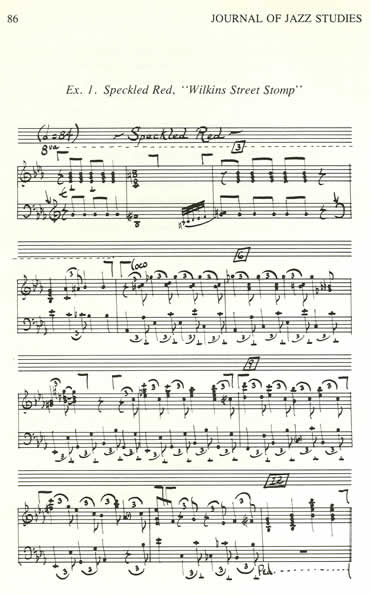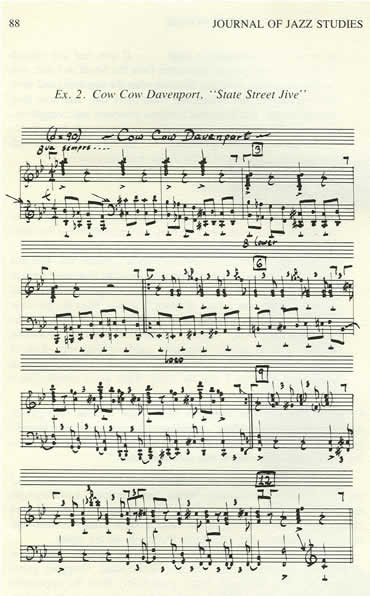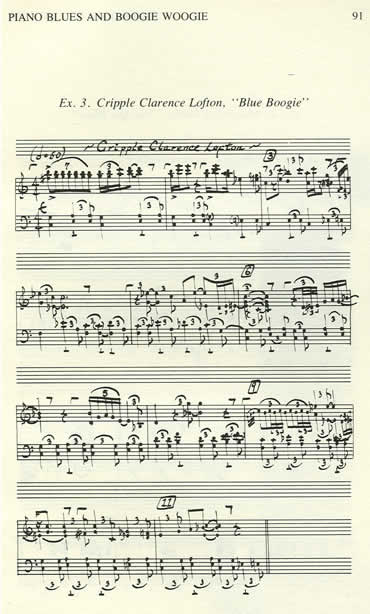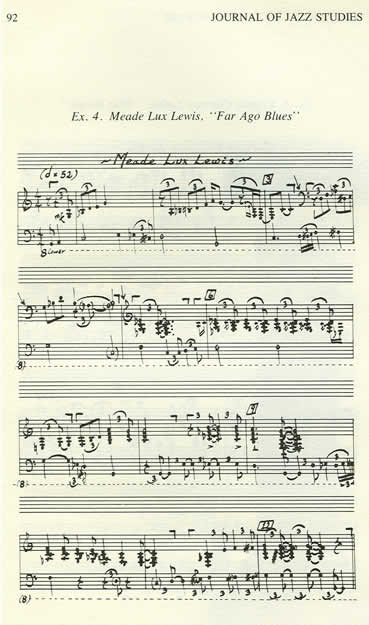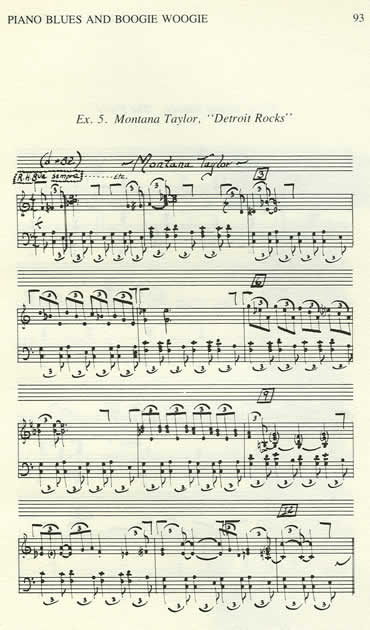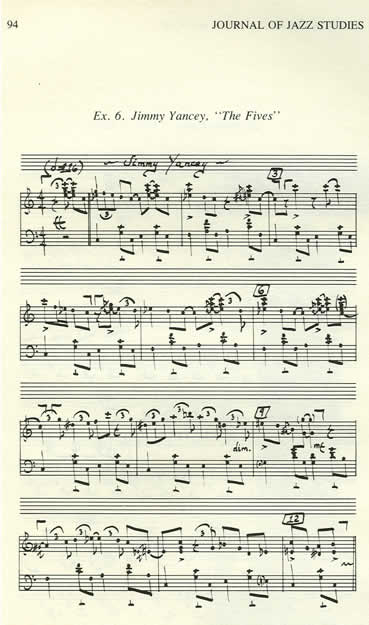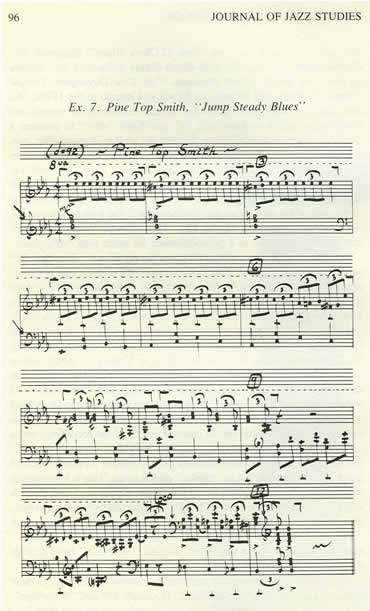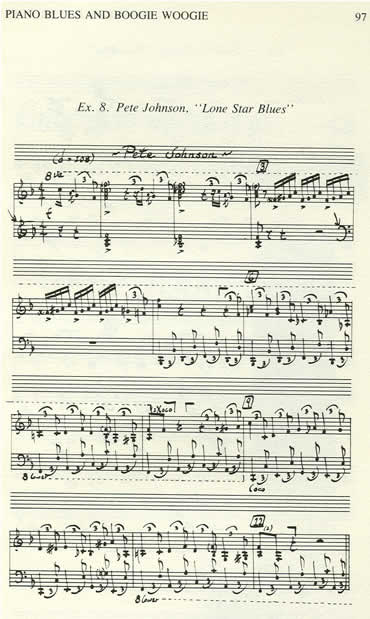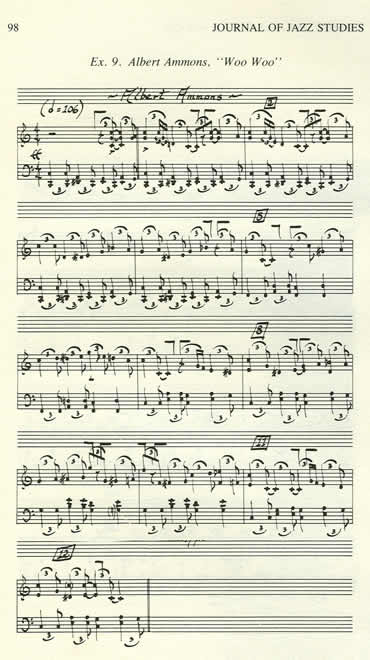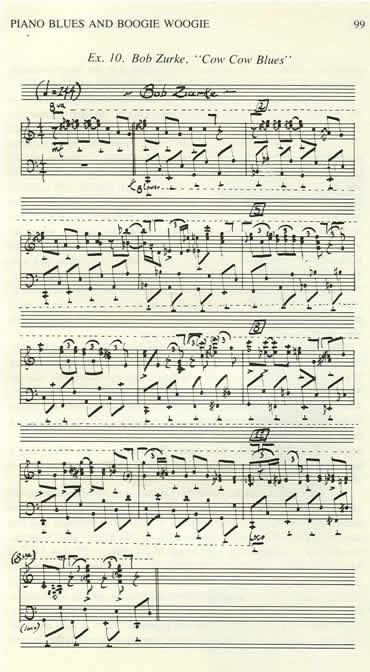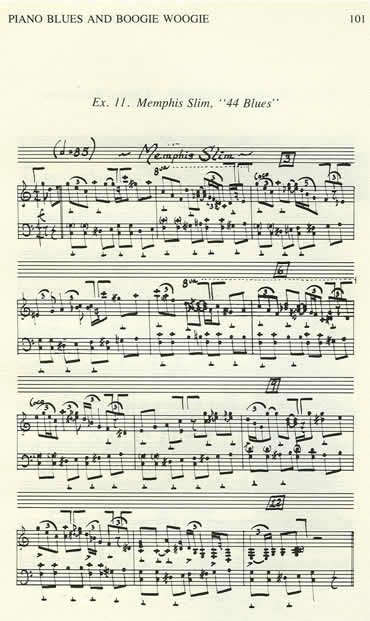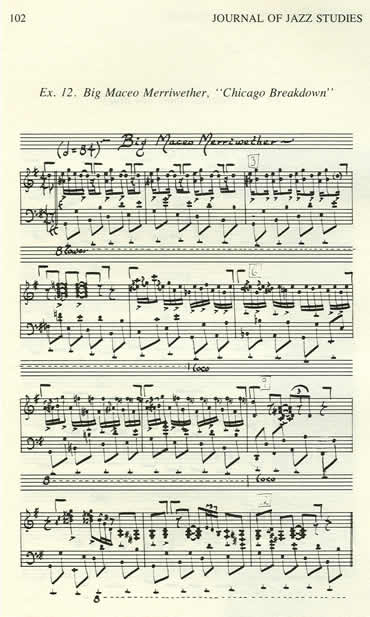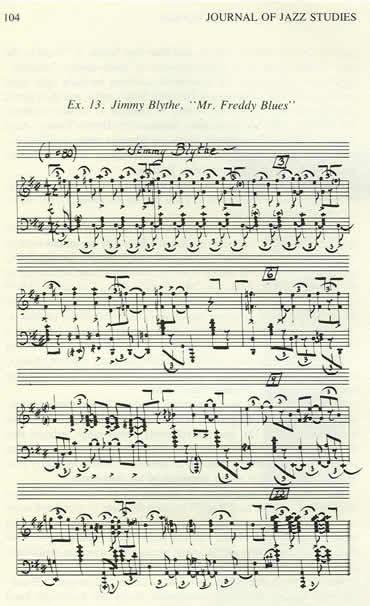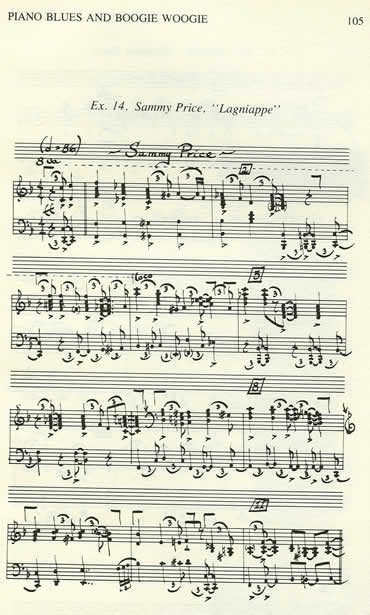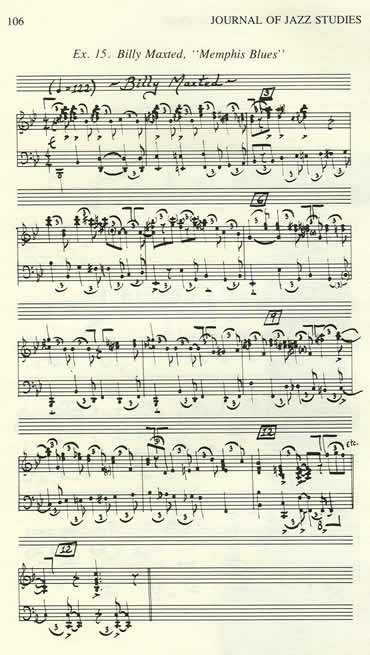35 - Leadbelly Adapts Boogie Woogie Bass Line from Piano to Guitar
History of Boogie Woogie — Thu, Mar 26, 2009
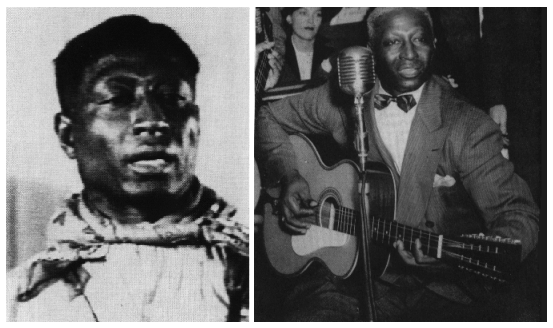
Leadbelly was among the first to adapt the rolling bass of Boogie Woogie to a guitar. He was born in 1888 (or 1889 depending on the source) and died in 1949.
According to “The Story of Boogie Woogie: A Left Hand Like God,“9 by Peter J. Silvester, with a special contribution from Denis Harbinson,
“....between 1872 and 1876, the Texas & Pacific Railroad had been laying track to the west of Shreveport at Marshall and to the north of Shreveport at Texarkana. In this general area, or in Caddo County, or in Shreveport itself, is where the blues singer and guitarist, Huddie ‘Leadbelly’ Ledbetter, first heard barrelhouse pianists playing boogie-woogie walking basses in 189935 (or 1901, depending on source).“9
On page 17 in his chapter on Boogie Woogie in Just Jazz35, Ernest Borneman notes:
“About 1900, Leadbelly heard an old-time Louisiana pianist named ‘Pine Top’ (not Clarence ‘Pine Top’ Smith) playing Boogie on Fanning Street.” (Borneman misspelled “Fannin” as “Fanning.”) Leadbelly was so inspired by this piano playing that he imitated Pine Top’s rhythmic piano style on his guitar.
Borneman quotes Leadbelly’s comments about Fannin Street’s Pine Top on page 17 of Just Jazz35:
“He played that Boogie Woogie. That’s what I wanted to play on guitar—that piano bass. I always wanted to play piano tunes. I got it out of the barrelhouses on Fannin Street.“35
Note: The “Pine Top” to which Leadbelly refers was not Clarence “Pine Top” Smith from Alabama who first used the word, “Boogie Woogie” in the title of his Boogie Woogie sound recording. Clarence “Pine Top” Smith was not born until June 11, 1904.
Leadbelly met fellow blues player, Blind Lemon Jefferson, in the Deep Ellum area of Dallas. For an uncertain period of time, they played together in Dallas. Deep Ellum developed as a mecca for original music in Dallas as a direct consequence of being at the crossroads of the Texas & Pacific Railroad and the Houston & Texas Central Railroad. This crossroads was important to the development of blues music in Texas. Leadbelly relied on the Texas & Pacific Railroad to transport him to Dallas. Moreover, he has stated that he and Blind Lemon used the T&P to travel to locations where they would perform together. Specifically, on page 22 of the chapter, “Blind Lemon Jefferson: That Black Snake Moan: The Music and Mystery of Blind Lemon Jefferson,” in the book, “Bluesland: Portraits of Twelve Major American Blues Masters,“28 Alan Govenar wrote of Leadbelly’s recollections about Leadbelly’s and Blind Lemon’s travels on the Texas & Pacific Railroad: “Leadbelly remarked that they were often able to get free rides on the Texas & Pacific Railroad in exchange for their playing.”28
Leadbelly could be responsible for having taught Blind Lemon Jefferson to play a walking bass line on Jefferson’s guitar. According to Sammy Price, Jefferson called his walking bass line his “booga-rooga.“40
© 2009 John Tennison
34 - The First Recording to Use a 12-Bar Blues Harmonic Progression with a Boogie Woogie Bass Figure
History of Boogie Woogie — Thu, Mar 26, 2009
In addition to using Boogie-Woogie bass figures with some some degree of inherrent swing, George W. Thomas Jr.‘s “The Rocks,” recorded in February 1923, is said to be the first Boogie Woogie recording to employ a 12-bar blues structure.
© 2009 John Tennison
33 - Jimmy Blythe’s “Chicago Stomp:” The First “Completely Boogie Woogie” Recording
History of Boogie Woogie — Fri, Mar 06, 2009
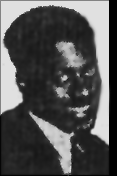
Unlike other early recordings of Boogie Woogie, Blythe’s “Chicago Stomp” is significant in that, after its short introduction, it maintains a Boogie Woogie feel and pulse to the end with no intermittant use of the 2/4 oom-pah pulse heard throughout most Ragtime music. Interestingly, unlike many other Ragtime pieces (such as Eubie Blake’s “Charleston Rag”), Jimmy Blythe’s piano teacher, Clarence M. Jones played his “Daddy Blues” and his “Doggone Blues” with a distinctive swing pulse that could have influenced Blythe to impart more of a swing to Blythe’s own music. Blythe recorded “Chicago Stomp” in April of 1924 in Chicago, Illinois, on the Paramount Label, #12207. Blythe’s “Chicago Stomp” can be regarded as an important contribution to the maturation of Boogie Woogie that occurred in Chicago well before Meade Lux Lews or Pine Top Smith made their recordings, and well before Boogie Woogie became publicly associated with Lewis, Smith, Ammons, Johnson, and Yancey.
© 2009 John Tennison
32 - Black Swan Records - The Record Label that Recorded Fletcher Henderson’s “Chime Blues”
History of Boogie Woogie — Thu, Mar 05, 2009
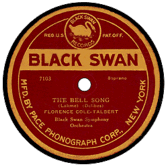
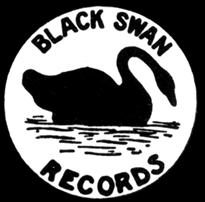
Black Swan Records was the first back-owned record label. The label was founded by Harry Pace, who was from Georgia. Before moving to New York to start his record label, Pace had run a music publishing company in Memphis with W. C. Handy. Fletcher Henderson had worked as a pianist and demonstrator for Handy and Pace’s publishing company. Thus, Henderson’s exposure to the published African American music of the day would have almost certainly brought Henderson into contact with Artie Matthews’ 1915 sheet music for “The Weary Blues” and with George W. Thomas Jr.‘s 1916 sheet music for “New Orleans Hop Scop Blues.” This experience would have exposed Fletcher Henderson to the use of the Boogie Woogie broken-octave walking bass line approximately 8 years before Henderson recorded his “Chime Blues” circa March, 1923 on Swan Records. Thus, the distribution of sheet music to Memphis, Chicago, and New York is a plausible explanation for how Fletcher Henderson came to use such a bass figure in his “Chime Blues.”
© 2009 John Tennison
31 - Fletcher Henderson’s “Chime Blues” is an Early Boogie Woogie Recording
History of Boogie Woogie — Mon, Jan 19, 2009
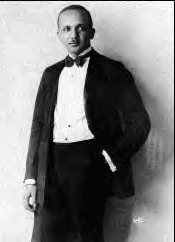
According to one website (http://www.redhotjazz.com/fletcher.html) Henderson’s “Chime Blues” was recorded in “January of 1921” on Black Swan Records. However, according to historical accounts, Black Swan Records did not make its first recordings until April, 1921. Moreover, these historical accounts indicate that the first recordings of Black Swan Records did not include Fletcher Henderson’s “Chime Blues.” Moreover, the most authoritative document on the history of Fletcher Henderson and his music (“Hendersonia”, Jazz Monographs Number 4, 1973, Walter C. Allen) indicates that he recorded “Chime Blues” in “early 1923.” On Page 44, Hendersonia states”
“In early 1923, Fletcher Henderson recorded a pair of piano solos for Black Swan, which were issued on their rare 2100 series. Chime Blues features a walking bass, and although Henderson was never known as a boogie-woogie pianist, this must be one of the earliest such solos on record (with the possible exception of the mysterious Clay Custer’s [A.K.A. George Thomas] ‘The Rocks’ on OKeh 4809, recorded about this same time). It would be interesting to know where Henderson picked up this style!”
Moreover, on page 548, Hendersonia states, “....one of the earliest known examples of boogie-woogie bass takes place on Fletcher’s rare piano solo of Chime Blues.”
Bryan Rust’s authoritative three-volume set titled, “JAZZ AND RAGTIME RECORDS (1897-1942),” Malcolm Shaw, editor, indicates “circa March 1923” as the recording date for Henderson’s “Chime Blues.” Thus, this authoritative sources places the recording of “Chime Blues” in the month following the recording of “The Rocks,” not in 1921 as the Red Hot Jazz website had indicated. Of course, the word, “circa,” allows for wiggle room, in that it represents an approximation. Regardless of the dates of audio recordings, an indisputable fact is that Henderson’s circa March 1923 recording of “Chime Blues” occurred about 8 years after Artie Matthews’ 1915 sheet-music publication of “The Weary Blues, ” and about 7 years after the 1916 sheet-music publication of George W. Thomas’s “New Orleans Hop Scop Blues.”
Regardless of exact recording dates, both “The Rocks” and “Chime Blues” deserve recognition as being among the first audio recordings to use Boogie Woogie broken-octave walking bass lines containing an intrinsic swing-pulse in the left hand part. Moreover, these broken-octave, swung bass lines are qualitatively distinct from the duple-meter feel of the broken-octave bass lines in Joplin’s “Pine Apple Rag” and in Boone’s “Southern Rag Medley 2.”
Since Henderson was a demonstrator of the African American sheet music of his day, Henderson could easily have picked up the idea for the Boogie Woogie swinging broken-octave walking bass line either from this previously published sheet music of Artie Matthews or George Thomas, or by rushing out to emulate the bass line in “The Rocks” shortly after hearing the studio performance or recording of “The Rocks,” as recorded in February of 1923. However, since George Thomas notated the swing pulse of his 1916 music with grace notes rather than with eighth-note triplets or doted eighth-notes, it seems more likely that Henderson would have modeled a witnessed performance by someone who was playing with an swing-pulse intrinsic to the left hand. Else Henderson could have ended up with an interpretation that sounded more like Eubie Blake’s grace-noted (AKA “reverse Boogie Woogie”) broken octave bassline as Blake used in his 1917 piano roll recording of Blake’s “Charleston Rag.”
Another feature that suggests that Henderson was emulating either “The Weary Blues” or “New Orleans Hop Scop Blues” comes from comes from the fact that “Chime Blues” clearly copies the structure of “The Weary Blues” and “New Orleans Hop Scop Blues.” Specifically, “Chime Blues” begins with a Ragtime oom-pah pulse, transitions into a Boogie Woogie swinging broken-octave walking bass, and then returns to a Ragtime oom-pah pulse, making the resemblance of “Chime Blues” to the structure of “The Weary Blues” and “New Orleans Hop Scop Blues” unmistakable.
Also, both “The Rocks” and “Chime Blues” have rudimentary polyrhythmic interplay between the right and left hands. Both “Chime Blues” and “The Rocks” pre-date Meade Lux Lewis’s “Honky Tonk Train” and Clarence “Pine-Top” Smiths “Boogie Woogie” recordings.
If you are curious to hear “Chime Blues,” go to http://www.redhotjazz.com/fletcher.html. (I cannot guarantee that this link will always be active.)
© 2009 John Tennison
30 - The Earliest Sound Recordings Containing Boogie Woogie Bass Figures
History of Boogie Woogie — Fri, Jan 16, 2009
“The Rocks” by George & Hersal Thomas (recorded February, 1923) and “The Fives,” (performed by Joseph Samuel’s Tampa Blue Jazz Band) and also written by George & Hersal Thomas (and also recorded February, 1923) are the earliest sound recordings of which I am aware that contain Boogie Woogie bass figures. Moreover, Fletcher Henderson’s recording of “Chime Blues” on Black Swan Records was recorded at a similar time (circa March,1923) and also contains a Boogie Woogie bass figure.
Thus, the February 1923 recordings of “The Rocks” and “The Fives” should be regarded as a 1st-place tie for the earliest sound recording containing a Boogie Woogie bass figure.
The first sound recording of which I know of George W. Thomas’s “New Orleans Hop Scop Blues” was also made in 1923 on OKeh Records.
The February 1923 recording of “The Rocks” lists “Clay Custer” as the piano player. While this person is commonly regarded as having been George Thomas, Jr., this conclusion is still uncertain. Although some have written that “Custer” was the maiden name of George Thomas’s mother, the Oxford Guide to Recorded Blues and Gospel disputes this claim, stating that Custer was not George’s mother’s maiden name.
© 2009 John Tennison
29 - U. S. Highway 59 from Texarkana to Houston to El Campo - “The Boogie Woogie Highway”
History of Boogie Woogie — Tue, Jan 13, 2009
U. S. Highway 59 from Texarkana to Houston to El Campo - “The Boogie Woogie Highway”
(A.K.A. “The Boogie Woogie Corridor”)
The migratory pathway of Leadbelly (from Mooringsport, Louisiana to Dallas, Texas) takes him through Marshall, Texas no later than the time that the Thomas family probably came through Marshall. Also, Leadbelly was known to have spent some time in the Texarkana area, a town through which the Thomas family almost certainly passed on their migration to Houston, TX. These correspondences of Leadbelly’s overall east-to-west migration with the Thomas family north-to-south migration, coupled with Thomas’s having said that he based his “Hop Scop Blues” on music being played in East Texas point strongly to Northeast Texas/Northwest Louisiana as the area where we have what appears to be the earliest eyewitness report of Boogie Woogie being played in 1899.35 (Note: Eubie Blake’s alleged 1896 account is not credible. See section below.)
Specifically, Ernest Borneman notes on page 14 in his chapter on Boogie Woogie (Chapter 2) in the 1957 book, “Just Jazz"35:
“Leadbelly says he heard it first in 1899 in Caddo County on the Texas Border.”
35
In reality, there is no “Caddo County.” However, there is a Caddo “Parish,” the Louisiana equivalent of a “county.” Moreover, Caddo Parish and Harrison County, Texas straddle the Texas border. Therefore, the exact location of this Leadbelly’s eyewitness account remains uncertain. If you give more credence to the word “Caddo,” you might conclude that it was on the Louisiana side of the border. However, if you give more credence to the words, “county,” and “Texas Border,” you might think it more likely to conclude that Leadbelly heard the music on the Texas side of the border. One thing is for certain: The region was culturally unified and the state boundary was defined only by a line of longitude, not by a barrier such as a River. Thus, locations of Railroads, Roads, and known music venues would be more reliable clues as to which side of the border Leadbelly first heard Boogie Woogie. Regardless, by 1899, it was almost certainly being played on both sides of the Texas-Louisiana state border.
(Note: For reasons discussed below, I do not believe Eubie Blake’s claim of hearing Boogie Woogie in Baltimore in 1896.)
To the extent that the earliest Boogie Woogies were influenced by the same forces that were shaping the right-hand parts in Ragtime, Scott Joplin’s family’s migration from Marshall and/or Linden, Texas to Texarkana suggests the regional presence of influences that almost certainly informed the earliest Boogie Woogie well before 1899. (Joplin’s father moved the Joplin family to Texarkana so that he could take job with the Texas & Pacific Railroad.) Indeed, some of the syncopated right-handed parts of Ragtime are virtually indistinguishable to what appears in the right-handed parts of Boogie Woogie. If it were not for Boogie Woogie having gotten away from the straight, oom-pah pulse of Ragtime, and if it were not for the polyrhythmic interplay between right and left hands in Boogie Woogie, it might have never come to be regarded as a style distinguishable from Ragtime. The Texas & Pacific tracks between Texarkana and Marshall are still in use by Union Pacific, and parallel Highway 59. South of Marshall, Highway 59 continues to Houston along the route of what was the Houston, East, and West Texas Railroad. This route takes Highway 59 through some of the most prominent lumber towns of the late 1800s (including Lufkin & Diboll) where various barrelhouse existed at the lumber camps. Moreover, lumber baron Arthur Temple (who controlled Diboll) lived in Texarkana and traveled back and forth between Texarkana and Diboll.) Moreover, George W. Thomas, Jr. brought Boogie Woogie to Houston.
From Houston, Highway 59 turns westward towards El Campo, Texas. As Highway 59 exits Harris County and enters Fort Bend County, it passes by Stafford, the birthplace of Boogie Woogie pianist, Robert Shaw (born 1908). Stafford is historically important because it was an initial west terminus of the very first railroad in Texas, The Buffalo Bayou, Brazos and Colorado Railroad. According to the Texas Handbook of History in George C. Werner’s article on “Railroads”:
“Work on this railroad began in 1851, and the first locomotive, named for Sherman [General Sidney Sherman], arrived in late 1852. The initial twenty-mile segment from Harrisburg (now a part of Houston) and Stafford’s Point (now Stafford) opened by September 7, 1853. The Buffalo Bayou, Brazos and Colorado was not only the first railroad to operate in Texas, it was the second railroad west of the Mississippi River and the oldest component of the present Southern Pacific.”
47
Since slavery had not been abolished at the time the Buffalo Bayou, Brazos and Colorado Railroad was built, this earliest stretch of Texas railroad was built largely by slave labor. Moreover, prior to the end of the Civil War, slaves’ access to pianos was limited. Consequently, piano music at slave-populated railroad camps associated with the construction of this track would have been limited, if present at all. However, the sound of the early steam locomotives on this line no doubt served as auditory inspiration for music that followed. Also, even as late as 1910, Fort Bend County had an African American population that rivaled that of Harrison County in Northeast Texas.
After traversing Fort Bend County, Highway 59 reaches El Campo, the birthplace of Boogie Woogie great, Little Willie Littlefield, who (along with Amos Milburn of Houston) had a profound influence on Fats Domino, Little Richard, and Jerry Lee Lewis. Moreover, El Campo is located in Wharton County, which, although not as high as Fort Bend County, has historically had one of the highest African American populations in Texas.
Thus, for all of these reasons, I call Highway 59 from Texarkana to Houston to El Campo “The Boogie Woogie Highway” or “The Boogie Woogie Corridor.” It might make sense to include stretches of Highway 59 north of Texarkana or west of El Campo as part of “The Boogie Woogie Corridor.” However, to do so, I would want to support such a designation by knowledge of Boogie Woogie players or sources of influence north of Texarkana or west of El Campo. For example, Lee Ree Sullivan of Texarkana reported to me in a1986 interview that his Boogie Woogie mentors had told him that Boogie Woogie was being played at logging and construction camps along the Texarkana and Northern Railroad (later known as the Kansas City Southern Railroad)68. The first 10 miles of the Texarkana and Northern were constructed in 1885, and run northward from Texarkana to the Red River along present-day Highway 59.
Moreover, since Robert Johnson made his first recordings in San Antonio, Texas, and since Louis Jordan was inspired by the Texas and Pacific Railroad presence in El Paso, Texas, I would not want to rule out possible Blues and Boogie Woogie influences west of El Campo. However, in general, one can visualize a “Boogie Woogie and Blues Gradient” that becomes more intense as one travels from West to East Texas. (The fact that parts of U. S. Highway 59 are going to become the new Interstate Highway 69 is a fitting metaphor for the libidinal energy associated with Boogie Woogie.)
© 2009 John Tennison
28 - Eubie Blake’s “Charleston Rag”
History of Boogie Woogie — Sun, Jan 11, 2009
Eubie Blake’s “Charleston Rag:”
A 1917 Piano Roll with a Non-Swinging, Grace-Noted, Broken-Octave Walking Bass Line
One of the earliest Ragtime piano rolls recorded that had a non-oom-pah, broken-octave walking bass line was Eubie Blake’s 1917 piano roll of “Charleston Rag,” copyright August 8, 1917, and recorded as a piano roll in late 1917 in New York, NY on Ampico roll 54174-E. However, Blake’s walking bass line is not typically regarded as a Boogie Woogie bass line, but rather as a “Reverse-Boogie Bass"58 figure. That is, Blake plays the lower note of each octave couplet as a grace note, with the 2nd note of each octave pair falling on the down beat, which sounds almost like a progression of unison octaves, rather than being a progression of note pairs in which one note in each pair is in the “swung” syncopated position off of the downbeat that allows for the poly-rhythmic feel, and interplay between left and right hands as heard in Boogie Woogie. A performance of the “Charleston Rag” piano roll can be heard on the 2003 Biograph album, “The Greatest Ragtime of the Century” and the Biograph album, “Eubie Blake: Memories of You” CDs.
Interestingly, in the 1917 piano roll of “Charleston Rag,” Blake plays his “grace-note” broken-octave walking bass line with accents as if they could have been derived from a literal reading George Thomas’s “New Orleans Hop Scop Blues”, published in 1916. That is, in Thomas’s original 1916 publication of “New Orleans Hop Scop Blues,” the lower note in each octave pair of the swinging broken-octave walking bass was notated as a grace note, suggesting to the uninformed reader that the lower note in each octave couplet was not supposed to be given the same accent as the higher note an octave up that immediately followed. Thus, anyone who was giving Thomas’ sheet music a literal reading, and who had not heard “New Orleans Hop Scop Blues” played the way George Thomas intended could have mistakenly thought that the piece was supposed to be performed in the literal “grace-note” fashion as we hear in Eubie Blake’s 1917 piano roll of “Charleston Rag,” and thus would also lack the swing feel so important to Boogie Woogie and Jazz in general.
Since Blake’s grace-noted, non-swinging, broken-octave walking bass line would result from a literal reading of the broken-octave bass line in the sheet music of George Thomas’s “New Orleans Hop Scop Blues,” the possibility that Blake was influenced by the 1916 sheet music of “New Orleans Hop Scop Blues” seems plausible. That is, if east-coast musicians made a literal reading of the grace notes printed in Thomas’s 1916 sheet music, the rhythm would be consistent with the rhythm heard the following year in Blake’s piano roll performance of his “Charleston Rag.” In 1969, Blake claims to have composed “Charleston Rag” before 1900 and says he says he did not know how to write music at that time. Given the relatively greater technological sophistication of the east coast United States at the time as compared to locations in the west, it is perplexing that it would have taken Blake over 17 years to find a way to document a walking bass line that just happens to sound like a literal rhythmic reading of George Thomas’s “New Orleans Hop Scop Blues” sheet music that was published in the prior year of 1916. (For a further discussion on unbelievable claims made by Eubie Blake, see the section on him below.)
Because Blake’s grace-noted bass line in Charleston Rag is not a Boogie Woogie bass line, it was instead referred to as a “Reverse Boogie Bass“58 in 1973 by Robert Kimball and William Bolcom in their book, ““Reminiscing with Noble Sissle and Eubie Blake,” in which the authors state the following on page 42:
“One day a neighbor lady called on Emma Blake. ‘Sister Blake, I heard someone, sounded just like little Hubie, playing at Aggie Shelton’s [a Baltimore brothel] the other night. And I know it’s little Hubie, Em, because of that wobble-wobble in the left hand.’ The ‘wobble-wobble,’ the sort of reverse boogie bass that is still Eubie Blake’s trademark, is found in his earliest composition, “Charleston Rag”—here it would get him into trouble.“58
The “trouble” to which the authors refer is the fact that this story conveys how Eubie Blake’s mother is said to have discovered that he had been playing at Aggie Shelton’s brothel.
© 2009 John Tennison
27 - Important Distinctions between Five Kinds of Broken-Octave Bass Figures
History of Boogie Woogie — Thu, Jan 08, 2009
What are the necessary and sufficient elements to constitute a broken-octave Boogie Woogie bass line? Some historians have erroneously referred to ANY broken octave bass line as a Boogie Woogie bass line. Yet, there are specific reasons why a broken octave bass is NOT sufficient in and of itself to create a Boogie Woogie feel. For example, broken octaves have been used in the keyboard music of Bach and other classical composers, and at least as early as 1908 in the Ragtime music of Scott Joplin. Although it only occurs for two measures, a broken-octave bass line can be seen on page 6 of Joplin’s “Pine Apple Rag,” first published in 190841. These broken octaves were played with Ragtime’s typical oom-pah pulse, and are not swung. Thus, the mere fact of playing in broken octaves was not a breakthrough for Boogie Woogie, nor does the usage of broken-octaves necessarily yield a Boogie Woogie bass line.
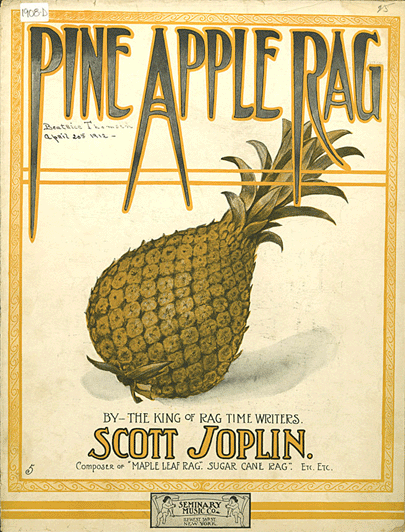
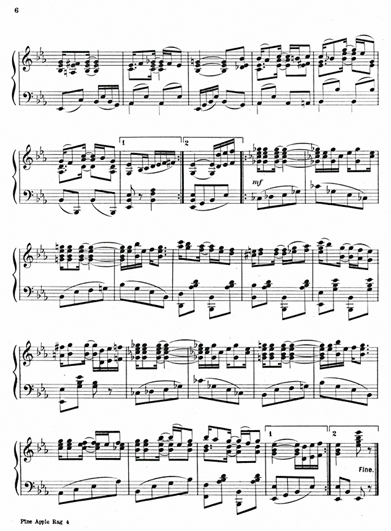
Above is the cover and page 6 of Scott Joplin’s Pine Apple Rag. A broken-octave bass line can be seen in the 5th & 6th measures on this page.
The images above are taken from the University of Colorado Digital Sheet Music Collection.
In Bach’s music and in Ragtime, the broken octaves were not played with an inherent swing pulse. The breakthrough transitions when the walking quality, ostinato figures, and/or the swing pulse of Boogie Woogie bass figures began to be used. In contrast, the bass chords in Ragtime frequently changed with each oop-pah. Such regular chord changes prevented an ostinato effect to be felt as strongly, if at all, and typically, Ragtime players were “striding,” not “walking,” as is more often heard in Boogie Woogie.
Even without what I call “Intrinsic Swing Pulse” in the left-hand bass line, a swing pulse can be created in Ragtime by the combination of a non-swinging right hand part (playing the syncopated notes that do not occur on the downbeat) with a non-swinging left hand part (playing the notes that occur on downbeats). I call the Swing Feel created by this technique an “Interactional Swing Pulse.” Some Ragtime pieces are played with this effect, but usually the amplitude (loudness) of the straight, oom-pah pulse of the left hand pulse of the left hand in Ragtime competes with the Interactional Swing Pulse, such that the net effect is a performance that does not swing as hard, and thus, still sounds like Ragtime, and is not experienced with as much of a Boogie Woogie feel.
To produce the strongest swing feel, the straight oom-pah pulse must be minimized, if not eliminated all together. To have the strongest swing feel, (unequal) “asymmetric” temporal divisions of 2/3 and 1/3 must be SUPERIMPOSED on top of a equal “symmetric” temporal divisions. Whether or not notes or rests occur at the various temporal divisions, the net effect of all notes and rests will define where the temporal divisions are located, and will determine whether or not a Swing Pulse is created.
With these ideas in mind, broken-octave bass figures can be classified into the following five categories. Category 5 is unequivocally a Boogie Woogie bass figure. Category 2 and 4 will be experienced as Boogie Woogie bass figures IF the bass figures have an interactional relationship to the right-hand part, such that a swing feel emerges. Even with an interactional swing pulse, categories 2 and 4 can be experienced with a Boogie Woogie feel if they have a walking and/or ostinato quality. if the bass has a “walking” and or “ostinato” quality. Categories 1 and 3 will not have a Boogie Woogie feel unless played with a walking and/or ostinato features.
1. Straight Broken-Octave Bass without “Interactional Swing Pulse” - These are non-Boogie-Woogie bass lines. This type of bass is the oldest of the broken octave bass lines, having been used by Bach, and on occasion by Ragtime composers, such as Scott Joplin. However, when Joplin used them, they were still written with a “1-2” oom-pah pulse. That is, if one simply changes the chord of the “pah” note to a single note an octave above the “oom” note, then you have a “broken-octave” bass line. Yet, such a simple variation is not sufficient to convert an oom-pah pulse into a swinging pulse.
2. Straight Broken-Octave Bass with “Interactional Swing Pulse” - The Interactional Swing Pulse probably first occurred in Ragtime music. However, given the competing, incessant oom-pah pulse of the left hand, the magnitude of most Interactional Swing Pulses heard in early Ragtime music was not strong enough to reach a threshold of a Boogie Woogie feel.
3. Grace-Noted Broken Octave Bass (also called a “Reverse Boogie Bass”58) without “Interactional Swing Pulse” - This is the type of broken-octave bass played by Artie Matthews in his “Pastime Rag No. 1 (A Slow Drag),” published in 1913 by Stark Music Company, St. Louis, MO42. In Matthews piece, the graced-noted broken octaves occur for 8 measures in the final “Grandioso” section of his piece. Like Joplin’s earlier “Pine Apple Rag,” I know of no evidence to suggest that the bass line “Pastime Rag. No. 1” was played with a swing pulse. Later, in 1917, Eubie Blake used a similar grace-noted broke octave in his “Charleston Rag” piano-roll performance, and then much later in his “Eubie’s Boogie,” first recorded in the late 1960s. Blake’s broken octave bass lines have virtually no inherent swing feel, although he does produce a very slight interactional swing pulse at times. Instead of sounding like two separate notes, the broken octave couplets in Blake’s basses tend to perceptually fuse together and sound like one musical event that was temporally widened, but with the accents still falling on the downbeats, and lacking an inherent swing feel. Thus, Blake’s bass lines in “Charleston Rag” and “Eubie’s Boogie” are not Boogie Woogie bass lines. Although I can appreciate what listeners mean when they say “Reverse Boogie Woogie Bass,” I feel that this term could confuse some into thinking (without having listened to Blake’s recordings) that his bass lines had simply inverted the accents of swinging bass line. However, his bass lines are NOT inversions of Boogie Woogie bass lines. Specifically, rather than being located at position the non-downbeat note in swinging broken-octave bass lines, the grace notes of Blake’s broken octaves are much closer to the downbeat note that comes immediately after the grace note. That, Blake’s temporal divisions of his broken octaves are far from the 2/3-1/3 temporal divisions that create a swing feel.
4. Grace-Noted Broken Octave Bass with “Interactional Swing Pulse” - As in category 2, a swing pulse can be generated form the interaction between left and right hand parts. The fact that the left-hand part is grace-noted results in it not competing as much with the Interactional Swing Pulse as in the case of the regularly-spaced oom-pahs of category 2.
5. Swinging Broken Octave Bass (A.K.A. having “Intrinsic Swing Pulse”) - This type of bass line (first published by George W. Thomas, Jr. in his “New Orleans Hop Scop Blues” in 1916) of a TRUE Boogie Woogie bassline. Later, such bass lines continued to mature in such pieces as Jimmy Blythe’s “Chicago Stomp” (See section on Jimmie Blythe.)
© 2009 John Tennison
26 - Another Early Sheet-Music Publication of a Boogie Woogie Bass Figure
History of Boogie Woogie — Mon, Jan 05, 2009
Another early sheet-music publication of a Boogie Woogie bass figure can be found in 1916 in George Thomas’s “New Orleans Hop Scop Blues.” Paul Oliver has noted that George Thomas based his “New Orleans Hop Scop Blues” on music that he had heard being played in East Texas.5
George W. Thomas, Jr. was born in Little Rock, Arkansas in 1883. (According to one account, George Thomas, Jr. died in March of 1930.) (I don’t know the place of his burial.) George Thomas, Jr. was the older brother of sister Beulah Thomas (later known as Sippie Wallace) and younger brother Hersal Thomas. The Thomas siblings often sang in the choir and played at the Shiloh Baptist Church. Hociel Thomas was the daugther of George W. Thomas, Jr.
George Thomas’s sister, Beulah Thomas (AKA Sippie Wallace), was born in 1898 in Houston. Thus, the Thomas family had arrived in Houston no later than 1898. Consequently, George Thomas, Jr. likely heard Boogie Woogie music on which he based his “Hop Scop Blues” during the migratory travels of the Thomas family from Little Rock Arkansas to Houston Texas, or possibly from a re-tracing of that pathway after having arrived in Houston. Such a migratory pathway would have most likely taken the family through Texarkana and Marshall, Texas, the headquarters of the Texas & Pacific Railroad, which had the most dense African American population in Texas. Moreover, not only did Marshall contain the repair shops for Texas & Pacific Locomotives, the Texas & Pacific Railroad also manufactured its own steam locomotives in Marshall, TX. Thus, the ostinato, musical sound of the steam locomotives would have been prominent in Texarkana and Marshall . However, Houston was also developing as the other early railroad hub in Texas.
© 2009 John Tennison
25 - The Earliest Sheet-Music Publication of a Boogie Woogie Bass Figure
History of Boogie Woogie — Fri, Jan 02, 2009
George Washington Thomas, Jr., is credited by Clarence Williams as playing with a Boogie Woogie bass figure in 1911 in Houston, Texas. Moreover, Clarence Williams credits Thomas with being the first man to write down a Boogie Woogie bass figure. However, George Thomas did not publish his Boogie Woogie bass figure until 1916 in his “New Orleans Hop Scop Blues.” In 1915, Artie Matthews published what is an undisputed Boogie Woogie broken-octave walking bass figure in his “The Weary Blues.” Although some might argue that Blind Boone’s 1909 sheet music publication of “Southern Rag Medley No. 2” would constitute the first “Boogie Woogie” bass figure, such a claim is disputable for reasons that I have argued above. However, “the cows,” which appears in a classic 12-bar form in “The Weary Blues” is a classic, undisputed Boogie Woogie bass figure, and one that is reported to have originated in Texas.5, 68
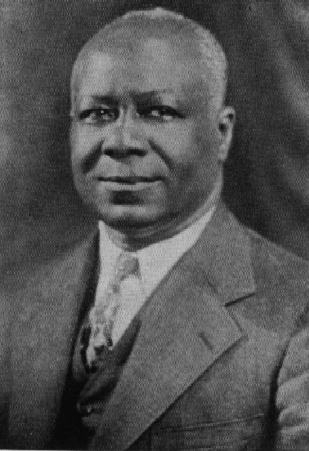
The bass figure used by Matthews in “The Weary Blues” is what has been clearly identified as “the cows,” one of the oldest Boogie Woogie bass figures that is said by Lee Ree Sullivan to have originated in Texas, and was also known as the “Texas and Pacific Bass” figure. Sullivan told me that “the cows” originally referred to the grace-noted right-handed figure that was meant to suggest the sound of cows being pushed away by the cow catcher grill at the front of steam locomotives. However, Sullivan said because the right-handed figure was usually accompanied by the left-handed “Texas and Pacific Bass,” the bass figure (which was intended to represent the sound of the steam locomotive), came also to be known as “the cows”.68 [The Texas & Pacific Railroad has a well-documented history of the significant challenges posed by cows on its tracks.] Moreover, Paul Oliver says that Cow Cow Davenport also borrowed “the cows” for use in his “Cow Cow Blues,” after having heard it being used in Texas.5
© 2009 John Tennison
24 - The National Spread of Boogie Woogie
History of Boogie Woogie — Fri, Jan 02, 2009
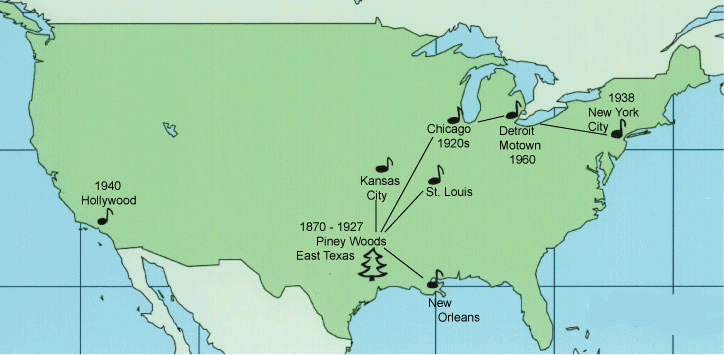
The above map was created by Krystyna Parafinczuk and is used with her permission. Thanks!
© 2009 John Tennison
23 - The Maturation of Boogie Woogie Paralleled the Maturation of Steam Locomotives
History of Boogie Woogie — Mon, Dec 22, 2008
The repetitive, ostinato, departing-acceleratory, chugging, thumping, rattling sound; as well as the bluesy Doppler-effected, pitch-shifted wail of steam whistles on steam locomotives inspired musical elements heard in Boogie Woogie and Blues music. Moreover, it is interesting to note that the maturation of Boogie Woogie paralleled the sound, power, and speed of maturing steam locomotive technology. Also of significance is that the 1920s maturation of Boogie Woogie occurred in Chicago (the nation’s largest railroad hub), and not in New York City. The development of Boogie Woogie in Chicago (and not in New York) might not be a coincidence in that Chicago’s laws allowed steam locomotives to come chugging into the heart of downtown past dwellings and businesses. However, New York City’s laws did not allow steam locomotives within the city limits. Thus, Boogie Woogie players who had moved to Chicago from the south had the continued opportunity to regularly hear and be inspired by the ever faster, ever louder, ever more powerful sound of maturing steam locomotive technology. People living in New York City, however, had fewer opportunities to hear and thus be inspired by these characteristics of the sound of steam locomotives.
The Texas Type 2-10-4 Super-Power Steam Locomotive: A Metaphor for “Fast Texas” (Boogie Woogie) Piano
The Texas Type 2-10-4s were among the increasingly faster and more powerful steam locomotives to be designed and produced in the 1920s. The ever-increasing tempo of performed and recorded Boogie Woogies correlated with the increasing speed and power of steam locomotives.
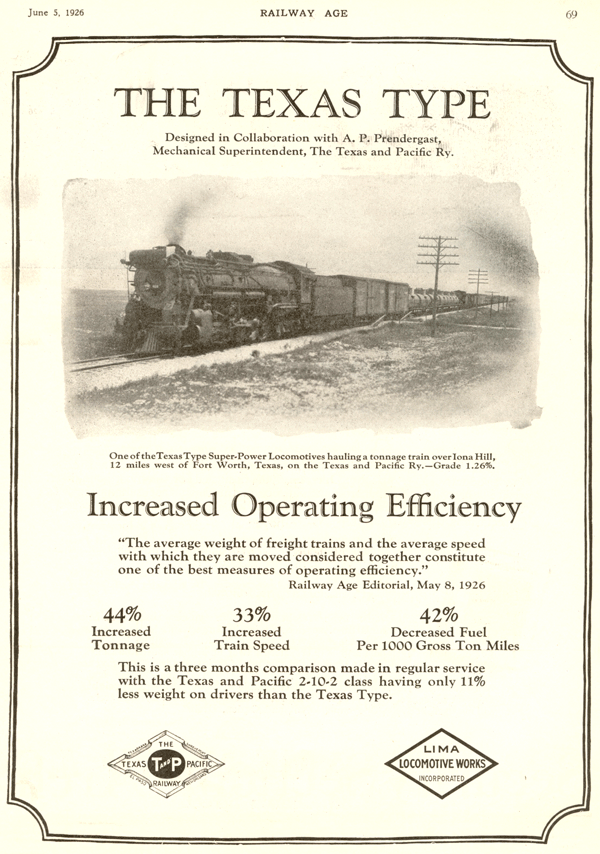
© 2008 John Tennison
22 - An Explanation of the “Jay Gould System” of Railroads
History of Boogie Woogie — Thu, Dec 18, 2008
Of all the railroad tycoons of nineteenth century, Jay Gould was perhaps the most notorious and hated. In 1880 (three years prior to the birth of George W. Thomas, Jr. in 1883), Jay Gould acquired control of the St. Louis, Iron Mountain, & Southern; the Texas & Pacific; and the International & Great Northern Railroads. As a result of Gould’s control of these three railroads, and his ruthless desire to maximize his own profits, Gould had advertisements published that emphasized travel on these railroads as a single system, one that came to be known as the “Gould System of Railroads.” Maps in timetable brochures for these railroads emphasized the routes in the Gould System with bold lines that suggested travel through and to certain destinations served by the Gould System, thus resulting in a flux of travelers through or to these destinations. Other advertisements in magazines and public signs emphasized travel involving locations served by the Gould System (See photo of Texas & Pacific sign in Deep Ellum below.) It was easier to travel on a route that had already been programmed for travelers, as compared to switching to a competitor’s line for which porters and others might be less motivated to provide assistance. Thus, not only does the migratory route from Little Rock to Houston that I have proposed for the Thomas family seem most likely from a standpoint of geographical efficiency, such a migratory route also seems most probable because all three railroads were part of the Jay Gould System.
Ultimately, all three of these railroads merged into the Missouri Pacific Company, which later merged into today’s Union Pacifc Railroad Company:
On May 12, 1917, the St. Louis, Iron Mountain and Southern was merged with the Missouri Pacific.
On March 1, 1956, the International & Great Northern was merged into the Missouri Pacific Railroad Company.
On October 15, 1976, the Texas & Pacific was merged into the Missouri Pacific.
In 1982, the Missouri Pacific Company merged with the Union Pacific Railroad Company.
© 2008 John Tennison
21 - Three Railroads in the Jay Gould System Probably Brought the Thomas Family to Houston
History of Boogie Woogie — Wed, Dec 17, 2008
1. St. Louis, Iron Mountain, & Southern (from Little Rock, AR southwest to Texarkana, TX). This railroad company was formed in May of 1874 from a merger of the St. Louis & Iron Mountain, the C&F, and the CA&T. The St. Louis, Iron Mountain & Southern Railway Company merged into the Missouri Pacific company in May of 1917. Thus, from 1883 until 1898 (when Beulah Thomas (George’s younger sister) was born in Houston), the St. Louis, Iron Mountain & Southern Railway Company would have been the logical choice for rail travel from Little Rock to Texarkana.
2. Texas & Pacific (from Texarkana, TX south to Marshall, TX and then west to Longview, TX). This railroad company was formed in 1871. Travel through Marshall would have taken the Thomases through the pounding sound of the town (am I some kind of poet?) of Marshall, the Chugging heart of the Texas & Pacific Railroad Manufacturing and steam locomotive maintenance shops. As stated elsewhere in this article, the Texas & Pacific Railroad company has a stronger association with the early development of Boogie Woogie than any other railroad. Thus, it is “The Boogie Woogie Railroad.” This particular part of the Texas & Pacific existed completely in the Piney Woods of East Texas.
3. International & Great Northern (from Longview, TX to Palestine, and then south to Houston). The International & Great Northern company was formed in September of 1873 from a merger of the Houston & Great Northern (formed October, 1866) and the International Railroad Company (formed August, 1870). Like the Texas & Pacific Route above, this part of the International & Great Northern exists completely in the Piney Woods of East Texas.
© 2008 John Tennison
20 - The Thomas Family: “The First Family of Boogie Woogie”
History of Boogie Woogie — Thu, Dec 11, 2008
George Washington Thomas, Jr. and his younger brother Hersal were regarded as seminal influences by later Boogie Woogie players, such as Albert Ammons and Meade “Lux” Lewis. Although both George and Hersal died tragically at a young age after they moved to Chicago, their having brought Boogie Woogie from the Piney Woods of East Texas to the Big Cities —first to Houston, then to New Orleans and Chicago—substantially influenced the course of popular music. Although Albert Ammons, Meade “Lux” Lewis, and Pete Johnson are often considered the prototypical “Big Three” of Boogie Woogie, there is no question that at least Ammons, Lewis, and Johnson drew much of their inspiration from George and Hersal Thomas, as well as from Clarence “Pine Top” Smith, who also suffered a tragically young death after moving to Chicago.
Since George Washington Thomas, Jr. was born in 1883 in Little Rock and since his father, George Thomas, Sr. became a deacon at the First Shiloh Baptist Church in Houston, and since younger sister Beulah (A.K.A. Sippie Wallace) was born in Houston in 1898, it is possible to trace what would have been the most likely migratory pathway used by the Thomas Family as they migrated from Little Rock, AR to Houston, TX. Before 1900, railroads would have been the most likely form of transport for African Americans and others travelling such a distance. Coming into contact with steam locomotives is consistent with their chugging sound, felt by many to sound like Boogie Woogie. Since George W. Thomas, Jr. says that he based his “Hop Scop Blues” (later “New Orleans Hop Scop Blues.”) on music he heard in East Texas, it would be logical to surmise that the migratory pathway of the Thomas family took them on the shortest railroad route that ran from Little Rock, through east Texas, and finally to Houston. Such a migratory path would have also taken the Thomas family through Marshall, Texas, the headquarters of the Texas & Pacific Railroad, and the only site (as far as I know) to have ever manufactured steam locomotives in Texas. Given these reasonable assumptions, the Thomas family probably relied on three railroads in the Jay Gould system to transport them from Little Rock to Houston as early as 1883 (the year of George Thomas, Jr.‘s birth) , but no later than 1898 (the year of Beulah Thomas’s birth).
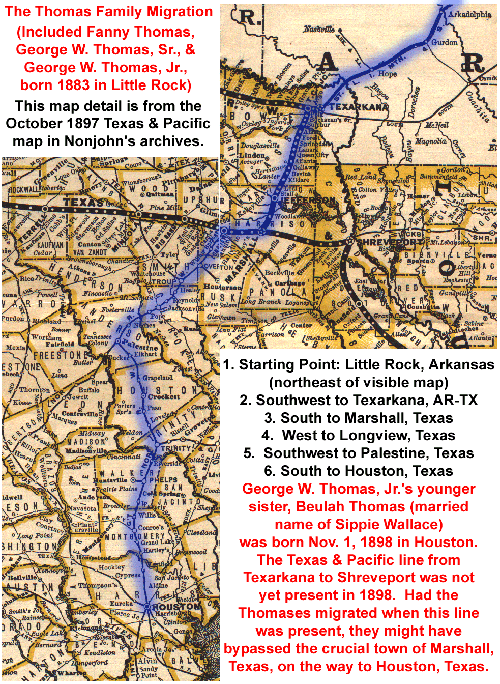
(Blue Highligting indicates the probable migratory pathway of the Thomas family after the birth of George W. Thomas, Jr. in 1883 - illustrated by Nonjohn. Copyright 2004. All rights reserved.)
© 2008 John Tennison
19 - Classically Trained Musicians Take Boogie Woogie Seriously
History of Boogie Woogie — Wed, Dec 10, 2008
In 1940 in the Introduction (page1) to “Boogie Woogie Piano Styles—No. 1 The History, Development and Art of Playing the Boogie Woogie Style,”17 Alec Templeton wrote:
“It was just ‘ragtime’ back in the post-world war days. Later they called it ‘jazz.’ In 1934 ‘swing’ became the thing. Today there is increasing popular interest in the style of music known as ‘Boogie Woogie.’”
“Ragtime, jazz, and swing each contributed materially to the progress of American dance music and I feel that boogie woogie, too, is destined for a permanent niche in the music field and that it will leave its mark as a purely American development, not only on dance music but on more serious music as well.”
“Already numerous ‘classical’ musicians of my acquaintance have accepted boogie woogie. They realize, as do I, that the Negro playing this peculiar style has achieved something actually creative. Many see in the simple harmonic structure of boogie woogie, with its unlimited possibilities of variations, the starting point of a much needed trend toward individualized, contrapuntal music, a conclusion to which I also subscribe.”
“Today, America is boogie woogie conscious. Dance bands throughout the land are featuring it. Dozens of phonograph records are being issued, featuring boogie woogie artists. I have found it a most interesting style myself, and must confess I derive unusual enjoyment playing it.”
In 1939 in Chapter VIII (“Boogie Woogie”) of Jazzmen1, William Russell wrote the following on page 205:
“The Boogie Woogie has made its influence felt in present-day orchestration, and many leading orchestras have their version of the Boogie Woogie. But it is fundamentally a piano style and is most effective when played on this solo instrument. Although the Boogie Woogie was originally dance music, it transcends any secondary function as mere accompaniment to words or movement and today has come to be recognized in its own right.”
Conlon Nancarrow is another classical musician who has appreciated and composed in a complex Boogie Woogie style. See section on Nancarrow below.
William Russell’s Chapter VIII in Jazzmen1, (titled “Boogie Woogie”) is possibly the first formal historical book chapter written specifically about the history of Boogie Woogie. However, other sections of Jazzmen besides Russell’s chapter also discuss Boogie Woogie.
© 2008 John Tennison
18 - Five Meanings of “The Fives”
History of Boogie Woogie — Tue, Dec 09, 2008
On page 17 of the February 19, 1959 issue of Down Beat, Meade Lux Lewis described “The Fives” as something that was done with the right hand, rather than the left. Moreover, in 1959, Lewis has trouble remembering the name of the piano player who played “The Fives” for him and Ammons. However, the article indicates the Lewis believed in 1959 that this pianist had been from St. Louis. The article states:
“Lewis considers that the primary reason for his shifting allegiance to piano [from violin] was the emergence on the Chicago scene of a pianist from St. Louis, Mo., whose name he cannot remember.“55
This account by Lewis indicates that this person who emerged on the Chicago scene by playing “The Fives” was not Jimmy Yancey, as Yancey was from Chicago, not St. Louis. Moreover, Lewis had named his “Yancey Special” after Jimmy Yancey. Thus, to imagine that Lewis would have been unable to recall Yancey’s name is hard to believe. Hersal Thomas’ death by poisoning back in 1926 would have been consistent with Hersal’s later obscurity and thus the difficulty that Lewis had in remembering Hersal’s name. Still, the fact that Lewis though the pianist who played “The Fives” was from St. Louis begs explanation. There are several possible explanations. First, Lewis might have mistakenly thought that Hersal was “from” St. Louis. Hersal almost certainly travelled through St. Louis on his way to Chicago, thus, in this sense, would have indeed been “from” St. Louis. This line of thought, taken along with Ammons’ claim that Hersal had brought “The Fives” to Chicago is consistent with Lewis having misattributed Hersal’s town of origin. Lastly, the article also indicates that Lewis had weighed as much as “298 pounds” and was “a short, round tub of a man….” who had “....began medical treatments for obesity, went on the wagon, and today sticks to orange juice and a regulated diet.” Thus, prior to having “went on the wagon,” Lewis’ years of excessive alcohol intake could easily have created memory problems for Lewis, causing him to have misattributed Hersal’s town of origin.
Lewis also indicates the following on page 17 in this 1959 Down Beat article about the man who played “The Fives”:
“This man played The Fives. It was something new and it got Ammons and me all excited. (Sure wish I could remember his name.) The best way to describe his way of playin’ is to say that the right hand played The Fives while the left hand didn’t matter. You could play any kind of left hand—a rumble bass, a walkin’ bass, and so on.“55
Since Ammons has said that Hersal Thomas was the first person to bring “The Fives” to Chicago, it is reasonable to infer that Lewis was talking about Hersal.
Of course, it is probable that “The Fives” has been used to refer to things that can be done by both the right and/or left hands, and thus both Lewis’ and Borneman’s explanations would be correct.
This explanation for the origin of the name, “The Fives,” contradicts the account given by Russell of being derived from a 5 O’clock performance time by Yancey or of a 5 O’clock departure time for a Chicago steam locomotive (as claimed by some historians).
Borneman’s and Lewis’s music-theory explanation for the origin of the term, “The Fives,” is consistent with other traditions in naming that allude to purely musical attributes, such as “8 to the bar,” and “Sixteen,” a term used by Eubie Blake to refer to playing four notes in the left hand for every one played in the right, thus yielding 16 notes in the left hand for each 4/4 measure played.
However, the cover and the lyrics of Hersal and George Thomas’s “The Fives” provide three other specific meanings for “The Fives.” George Thomas’s lyrics for “The Fives” refer to both a 5 p.m. and a 5 a.m. arrival time for a train arriving in “Frisco” [San Francisco] and a time at which “he got the engineer told….”:
“Five P. M. we due in Frisco….”
and
“We’ll be in Frisco tomorrow morn sure at Five….”
and
“Fireman turned on water and he shevel in some coal, Five o-clock this morning he got the engineer told….”
Although the line above clearly refers to a 5 a.m. time, it is not clear that it is referring to an arrival time, but appears instead to be the time at which the “Fireman” communicated with the “engineer.”
Although the lyrics do not explicitly mention “Chicago,” Thomas writes:
“I’m leaving town…”
and
“...that West bound train does Run….”
Thus, it is clear that Thomas meant to refer to a departure town with a location east of San Francisco. He might have intentionally been non-specific about the departure location so as to give the lyrics broader appeal. However, since George Thomas was living in Chicago when he wrote these lyrics, many have assumed that the “town” from which he is leaving is Chicago. However, I have not confirmed if there was actually a Frisco-bound train(s) with a “5” identification number, or whether there was a train(s) from Chicago that arrived in San Francisco at either 5 p.m. or 5 a.m. Still, Chicago seems to be the best working assumption.
The number 5 on the cover of the sheet music, and the fact that the train is 4-6-0 with 5 axels (see above) is consistent with George Thomas’ lyrics specifically referring to the locomotive as “Old Five” and “number 5” in the lyrics to “The Fives.” The fact that the number 5 is associated with the depicted train in these two ways suggests meanings beyond referring only to a time of arrival. Moreover, in addition to the system of notation that classifies steam locomotives by the number of wheels, classifying steam locomotives is by their number of Axels is common. That is, the steam locomotive on the cover of “The Five’s” sheet music is a 4-6-0 (by number of wheels) and a “5” by number of axels. The system of classifying steam locomotives by their number of axels is still commonly used in Europe. Specifically, the lyrics state:
“Old Five ready to take me away,...”
and
“Here come number 5 she make a mile a minute…”
The fact that their is an apostrophe in the title, “Five’s” on the cover of “The Five’s” is quite likely to be semantically significant, as it implies that George Thomas wanted to refer to 5-axel steam locomotives in plural, rather than refer only to a specific steam locomotive using “5” as its identification number. Moreover, in Europe, 5-axel steam locomotives are still referred to as “the fives.” Thus, it makes perfect sense to use “The Five’s” to refer collectively to all 4-6-0 steam locomotives.
The final line of “The Fives” provides the most metaphorical meaning of “The Fives:”
“.....I’ve got the Frisco I mean Frisco evening Fives.”
At first glance, this line might appear to be referring to an evening arrival time. However, the expression “....I’ve got….” suggests a state of mind, such as when one says “I’ve got the Blues.” However, George Thomas does not appear to be referring a depressed or sad mood. Instead, given the exuberant imagery of Thomas’ lyrics, having the “Frisco evening Fives” sounds like he is ready to have an exciting night out in San Francisco.
Since George Thomas previously changed the title of his “Hop Scop Blues” to “New Orleans Hop Scop Blues,” and since he added lyrics referring to New Orleans to his purely-instrumental “Hop Scop Blues” that he had previously performed in Houston, a similar process probably took place when he wrote lyrics to “The Fives.” That is, “The Fives” could have originally been an instrumental piano piece, whose title referred to characteristics about the intervals or meter in right and/or left hands, but this would have not prevented George Thomas from giving “The Fives” new meanings by adopting lyrics inspired by this pre-existing name. By writing lyrics for “The Fives” while living in Chicago, Thomas could appeal to the desire of African Americans to travel from the hardships of Chicago or other cities to places that they imagined to be better, such as California.
Thus, “The Fives” has FIVE different meanings:
1. Left-Hand Characteristics
2. Right-Hand Characteristics
3. A Locomotive’s Characteristics - Identification Number or number of axels on a 4-6-0 (a.k.a. 10-wheeler) locomotive - “Old Five” & “number 5”
4. Times on the Clock - both 5 p.m. and 5 a.m.; including arrival times and a time at which the “Fireman….got the engineer told.”
5. “The Frisco Evening Fives”—a restless state of mind with an accompanying desire to transcend one’s current situation through travel and pleasurable activities.
© 2008 John Tennison
17 - Hersal & George W. Thomas, Jr. Influenced Many Boogie Woogie Players in Chicago
History of Boogie Woogie — Tue, Dec 09, 2008
Evidence that Ammons was influenced by Texas Boogie Woogie musicians (especially Hersal Thomas) who had moved to Chicago was provided in 1939 in Chapter VIII (“Boogie Woogie”) of Jazzmen1, where historian William Russell wrote the following on page 189:
“Albert Ammons is younger than most of the Chicago blues pianists, but he was old enough to be a member of the Eighth Illinois Home Guards during the World War. In his early teens he joined the bugle and drum corps. They had fourteen buglers and fourteen drummers; Albert was one of the drummers. Both his parents played piano. Not long after the war, he started to learn the blues and soon knew two or three good pieces. He listened to the Yancey brothers and to other Chicago pianists, including Hersal Thomas, another remarkable musician who never gained more than local fame. Hersal played all the favorite blues and was known especially for his own Suitcase Blues. In those days if a pianist didn’t know the Fives and the Rocks [composed by George and Hersal Thomas from Texas] he’d better not sit down at the piano at all. Whenever Hersal Thomas, who made a deep impression on young Ammons, came to a party, the other pianists were afraid to play; so he became unusually popular and got all the girls.”
Other evidence documenting the influence of George and Hersal Thomas on Albert Ammons and Meade “Lux” Lewis comes from “5 Boogie Woogie Piano Solos by All-Star Composers” (a book of sheet music) edited by Frank Paparelli, Copyright 1942, Leeds Music Corporation, RKO Building, Radio City, New York, NY.12 This source states:
“Albert Ammons and Meade ‘Lux’ Lewis claim that ‘The Fives,’ [copyrighted in 1921 and published in 1922] the Thomas brothers’ musical composition, deserves much credit for the development of modern Boogie Woogie. During the twenties, many pianists featured this number as a ‘get off’ tune and in the variations played what is now considered Boogie Woogie.“12
Indeed, all modern Boogie Woogie bass figures can be found in “The Fives,” including swinging, walking broken-octave bass, shuffled (swinging) chord bass (of the sort later used extensively by Ammons, Lewis, and Clarence “Pine Top” Smith), and the ubiquitous “oom-pah” ragtime stride bass.
In the liner notes to the 1967 Sippie Wallace album, “Sippie Wallace Sings the Blues,” released by Storyville Records, historian Paul Oliver wrote the following about the influence of and untimely death of Hersal Thomas:
“This was an irreparable loss to the piano blues as witness the memories and testimony of such performers as Jimmy Yancey and Albert Ammons. Every pianist tried to play his ‘Rocks’ and ‘Fives,’ and learned his figures from his [Hersal’s] records; one was Little Brother Montgomery from Louisiana whose support to Sippie on “Special Delivery Blues”, “I’m a Mighty Tight Woman” and “Murder’s Gonna Be My Crime” evoke shades of the great Hersal.“70
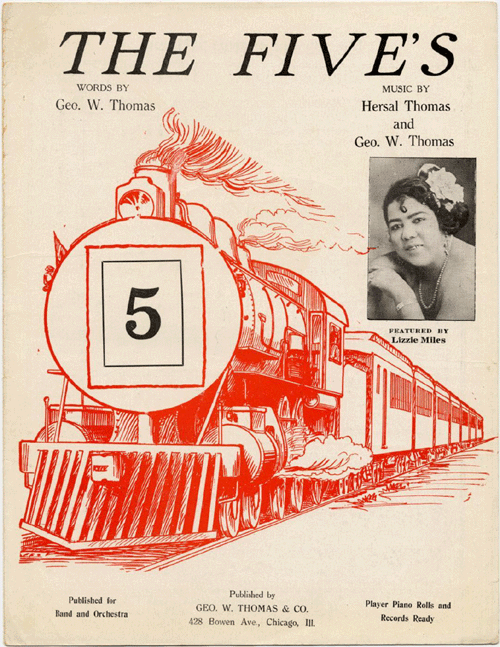
Above is the cover of the “The Five’s” (usually referred to as “The Fives” without an apostrophe), copyright registered in 1921 by Hersal and George, and published in 1922. If anyone has a full copy of this sheet music, I would love to hear from them at nonjohn@yahoo.com.
Although he provides some valuable historical information in “Jazzmen"1, William Russell mistakenly wrote that Jim Yancey had written, “The Fives.”
In “Jazzmen"1, Russell erroneously writes,
“Around five o’clock in the morning when almost everyone was knocked out and things were getting pretty dull and awfully quiet, someone over in a corner came to life and yelled out, ‘Let’s have some blues.’ Then Jimmy obliged with his Five O’clock Blues, known as the Fives for short.”
However, Borneman disputes the idea that “The Fives” are short for “Five O’clock Blues.” (See the Borneman quotation below.)35
In “Jazzmen"1, Russell also erroneously writes,
“His [referring to Yancey] first piece, the Fives, is probably the germ from which most of the piano blues of the Boogie Woogie type grew, and after a quarter of a century, it can still hold its own in dynamic interest and vitality when compared with later versions.”
Although Russell was mistaken to credit Yancey with having written “The Fives,” Russell was correct when he wrote that “The Fives” is “probably the germ from which most of the piano blues of the Boogie Woogie type grew….“1 However, it is Hersal and George Thomas who deserve the credit for spreading the musical motifs heard in “The Fives” from Texas to New Orleans, and then to Chicago. Witnesses to this fact include Albert Ammons, who indicates that Yancey was NOT the author of, “The Fives.” Instead Ammons claims that Hersal Thomas brought the “Fives” to Chicago. Ammons, who was a pupil who admired Yancey, would have had no obvious motivation to credit Hersal Thomas while discrediting Jim Yancey. Thus, Ammons’ claim should be taken seriously.
Specifically, Ammons’ refutation of Russell’s claim can be found on page 21 of Ernest Borneman’s chapter on “Boogie Woogie,” in chapter 2 of “Just Jazz"35:
“Hersal Thomas, composer of ‘Hersal Blues’ and ‘Suitcase Blues’, was the first person, according to Albert, to bring the ‘Fives’ to Chicago. Some critics have said that the Fives are short for ‘Five O’clock Blues’, a title under which Jim Yancey recorded them. But it seems much more likely that they take their name from that rudimentary boogie bass, fingered by first and fifth finger alone, which takes the tonic, adds the fifth and alternates back and forth between it and the sixth.“35
Moreover, William Russell in his chapter titled “Three Boogie-Woogie Blues Pianists,” in the book, “The Art of Jazz: Essays on the Nature and Development of Jazz,“62 edited by Martin Williams, Oxford University Press, 1959, states the following about Jimmy Yancey’s time on the T.O.B.A. circuit (page 100):
“Jimmy never played piano on the stage; in fact he didn’t start to learn it until he was fifteen.“62
Thus, since Yancey was born in 1898, Yancey did not start to play the piano until 1913, which is 2 years after George W. Thomas was witnessed by Clarence Williams to have been playing Thomas’ “Hop Scop Blues” (later renamed “New Orleans Hop Scop Blues”) in Houston, Texas. Thus, this lends still more evidence that Boogie Woogie had undergone significant development before Yancey ever started playing the piano.
On page 17 of the February 19, 1959 issue of Down Beat, Meade Lux Lewis speaks about the pianist who caused him to shift his allegiance from violin to piano:
“Lewis considers that the primary reason for his shifting allegiance to piano [from violin] was the emergence on the Chicago scene of a pianist from St. Louis, Mo., whose name he cannot remember.“55
and
“This man played The Fives. It was something new and it got Ammons and me all excited. (Sure wish I could remember his name.) The best way to describe his way of playin’ is to say that the right hand played The Fives while the left hand didn’t matter. You could play any kind of left hand—a rumble bass, a walkin’ bass, and so on.“55
Given the most probable railroad route from Texas to Chicago, Hersal Thomas would have almost certainly come “from” St. Louis to arrive in Chicago. Moreover, Meade Lux Lewis’ account of a man “from St. Louis” who “emerged on the Chicago scene” playing “The Fives” indicates that this person was not Yancey (who was from Chicago), and moreover, that Yancey had not been what inspired Lewis to switch his instrument from violin to piano.
In the April 19, 1924 issue of “The Music Trade Review,” an article titled, “A Juvenile Songwriter” stated:
“Hersal Thomas of Chicago [after moving from East Texas] enjoys the distinction of being one of the youngest songwriters in the world. He has just passed his fifteenth birthday…The outstanding song written by this young songwriter is entitled, “The Fives”...This was his first commercial recording and has been followed by others which are meeting with a good sale among the dealers.”
The CD “Boogie Woogie Blues” released in 1991 by Biograph Records contains digital recordings derived from the playback of piano rolls made by early Boogie Woogie artists. Among these is Hersal Thomas, who had moved from Houston to Chicago with his older brother, George W. Thomas, Jr. The liner notes of the “Boogie Woogie Blues” CD state:
“Hersal Thomas, king of Chicago’s house-rent party pianists in the middle 1920’s, was one of the first to record a Boogie Woogie solo.”
and
“Unfortunately, Thomas passed away at the age of twenty. However, his music lives on through many prominent Blues pianists of today.”
When speaking about the various piano players at ‘boogie’ or ‘house-rent’ parties in Chicago, Paul Oliver wrote on page 92 in The Story of the Blues5:
“They included the child prodigy, Hersal Thomas, whose appearance in Chicago and Detroit from Houston, Texas, at the age of fourteen created sensation and profoundly influenced the piano players who heard his grumbling basses and highly poetic melodic inventions.”
and (page 92)5
Hersal & George W. Thomas, Jr. Influenced Jimmy Yancey, Albert Ammons, Meade “Lux” Lewis, and Other Boogie Woogie Players in Chicago
Paul Oliver wrote, “Pine Top Smith took his wife, Sara Horton Smith, to Chicago and took the room on South Parkway in a building where, coincidentally two other piano-players, Mead ‘Lux’ Lewis and Albert Ammons, were also living.” Ammons has reported having contact with Pine Top Smith. Moreover, both Ammons and Lewis acknowledge having heard and having been excited and inspired by Hersal Thomas. Thus, given his proximity to Ammons and Lewis, Pine Top probably also heard the performances of Hersal Thomas, who was already in Chicago with his brother George no later than 1923 (prior to Pine Top Smith’s arrival). Moreover, Pine Top’s Boogie Woogie (1928), like than of Ammons and Lewis, clearly shows some elements used by the Thomas brothers.5
Moreover, Peter Silvester notes that Yancey’s 1939 Solo Art recording titled, “‘The Fives’ was basically the same piece as ‘Yancey Stomp’ and ‘Midnight Stomp.’” (page 50)9
These 1939 recordings on the Solo Art label were Yancey’s first recordings. Of these recordings, Peter Silvester states (page 50):
“It is strictly Yancey material and the titles given to it were probably concocted for the recording sessions.“9
Thus, Silvester indicates that titles used by Yancey in these 1939 recordings had NOT been the titles used to refer to Yancey’s musical material prior to 1939, but had simply been a re-titling of Yancey’s music.
Indeed, if Jimmy Yancey had been playing “The Fives” or similar material in the 1920s, it is hard to believe that he would not have had opportunities to record at that time, as nothing inhibited his communication with the talent scouts from the early record companies that were recording Yancey’s associates. Moreover, besides the thriving ‘race’ recording industry in Chicago at the time, Yancey’s having toured on the T.O.B.A. circuit would have given him numerous opportunities to have been discovered and to have traveled to and heard music from various places, including that from Texas. Lastly, unlike Lead Belly, Yancey (to my knowledge) was not incarcerated, which would have made it more difficult to record, as when Lomax had to bring the recording equipment into the prison to record Lead Belly.
Peter Silvester’s analysis (page 180)9 of Yancey also raises doubts about Yancey recording so late relative to the other Boogie Woogie players:
“It is a strange fact about Jimmy Yancey’s musical career that despite his popularity as a rent party pianist in the 1920s and 1930s he never entered a studio during this period when sale of ‘race’ records were at their height.“9
In summary, not only did Hersal and George Thomas influence Ammons and Lewis, the Thomases also influenced Jim Yancey, as evidenced by Yancey’s re-titling his music “The Fives” in 1939. This influence is chronologically consistent with the fact that Yancey did not make his first recordings until 1939, many years after after George and Hersal Thomas, and others made their first Boogie Woogie recordings.
© 2008 John Tennison
16 - Is Ragtime or Boogie Woogie More Difficult to Play?
History of Boogie Woogie — Mon, Dec 08, 2008
There is a long history of snobbery and resentment from some Ragtime players towards Boogie Woogie players. Interestingly, there does not seem to have been as much resentment from Boogie Woogie players towards Ragtime players. Specifically, the most resentment seems to have come from Ragtime players who tended to play with 2-to-the-bar, oom-pah, “striding” left hand bass figures.
Ragtime and Boogie Woogie players still sometimes get into arguments over whether Ragtime or Boogie Woogie is more difficult to play. For example, one dimension of variability in broken-octaves of Boogie Woogie and the oom-pah bass of Ragtime is the size of the stride between one broken octave couplet to the next in Boogie Woogie, or between the “oom” and the “pah” in Ragtime. Quite often, the arguments over difficulty arise over claims from Ragtime players who say the wide strides in their oom-pah left had parts are harder to play than the closer intervals in some Boogie Woogie bass lines. Yet, size of stride is a dimension of variability that can be made wider in Boogie Woogie or Ragtime, resulting in either style becoming very difficult to play. Consequently, a simple Ragtime piece with small strides would be easier to play that a complex Boogie Woogie piece with large strides. On the other hand, a complex Ragtime piece with large strides and frequently-changing chords would be harder to play than a rudimentary Boogie Woogie with a simple, shuffled-chord bass in a typical blues progression involving only I, IV, and V chords.
Boogie Woogie players will often argue that improvisation, and the independence of left and right hand required to create the complex polyrhythms of Boogie Woogie requires more skill than that typically required to play the striding bass of Ragtime. Yet, a Ragtime piece with a wide stride with ever-changing chords between each oom-pah requires a high degree of skill.
Therefore, since there is potentially infinite variability of difficulty in the genres of both Boogie Woogie and Ragtime, to globally label and stereotype one genre as harder or easier to play than the other makes no sense. Instead, it makes more sense to say that different (although somewhat overlapping) skill sets are required for each style of music.
© 2008 John Tennison
15 - Contrasts Between Boogie Woogie and Ragtime
History of Boogie Woogie — Thu, Nov 13, 2008
“They All Played Ragtime,“8 (But Only Some of Them Played Boogie Woogie)44
Although the words, “Boogie Woogie” and “Ragtime” have occasionally been used synonymously, there is no question that the modern meanings of these terms refer to different musical attributes. Nonetheless, some of the same sensibilities, especially in the right-hand parts, informed both Boogie Woogie and Ragtime.
Although his exact place of his birth is debated, evidence indicates that Scott Joplin, the Father of Ragtime, was born somewhere between Texarkana and Marshall Texas, possibly near Linden, where his family was known to be living not long after Scott’s birth. Scott Joplin’s father moved the Joplin family to Texarkana so that Joplin’s father could take a job with the Texas & Pacific Railroad. Scott Joplin took his first piano lessons in Texarkana. Joplin was known to have had a classically-trained German piano teacher, Julius Weiss, who was born in Saxony, one of the 16 states of Germany, circa 1841. Weiss might very well have brought a Polka “oompah” rhythmic sensibility from the old country to Texarkana, Texas, where Joplin was his pupil.
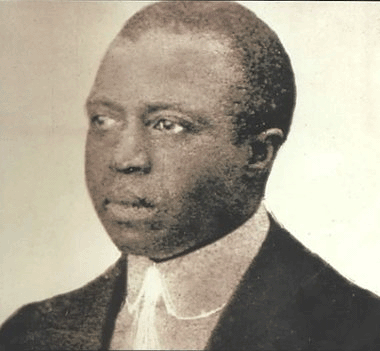
Scott Joplin
The syncopated right-hand melodic parts of Ragtime are very similar to the sorts of right-hand parts and motifs heard in Boogie Woogie. Indeed, Joplin’s real breakthrough was in bringing these syncopated and percussive right-hand motifs to the piano. According to “The History of the Blues” (1995 by Francis Davis, Hyperion, New York), “Ragtime borrowed its harmonic schemes and its march like tempos from Europe, but the syncopations that marked it as new were African-American in origin, possibly derived from the music of rural fiddle and banjo players.”7 However, Joplin’s left hand Ragtime bass lines did not break new ground. They were harmonically appropriate to support the right-hand parts, yet were not musically interesting or innovative in and of themselves. Consequently, as a result of its simplistic left-hand 2/4 “oompah” bass line, the Ragtime style has never resonated with me as strongly as Boogie Woogie. As compared to Boogie Woogie, Ragtime (mainly because of its left-hand parts) always felt too rigid, unvarying, and march like.
Indeed, in “The Smithsonian Collection of Classic Jazz” (1987, Smithsonian Institution Press)38, Martin Williams states (page 13), “Ragtime was basically a piano keyboard music and, one might say, an Afro-American version of the polka, or its analog, the Sousa-style march.” In this same publication Martin Williams also states (page 14) that “ragtime introduced, in the accents of its right-hand melodies, delightful syncopations onto the heavy 2/4 oompah rhythm of its cakewalk-derived bass line….“38 Yet, precisely because of the lack of syncopation in the left-hand bass lines, the poly-rhythmic potential of Ragtime was severely limited as compared to the simultaneous right and left-hand syncopations of Boogie Woogie, and other forms of Jazz that developed later.
The regular, and incessant, 2/4 “oompah” polka-like left-hand bass lines of Ragtime give it a distinctively different march like feel with less potential for the poly-rhythmic complexities when combined with right-hand parts. In contrast, the shuffled, walking, swinging, or “rolling” bass line of Boogie Woogie can yield substantial polyrhythmic complexity when combined with intricate right-handed parts of Boogie Woogie. Although some Ragtime had intricate right-hand parts, because of the unvarying, non-syncopated left-hand bass lines, Ragtime never realized the polyrhythmic heights achieved by Boogie Woogie. Indeed, in Music in a New Found Land: Themes and Developments in the History of American Music14, Wilfrid Mellers writes (page 278):
“When Cow Cow Davenport plays Atlanta Rag (45) we feel that the discipline of rag-forms restricts the invention which he could exhibit as a boogie-woogie player.”
In the same book14, Wilfrid Mellers also writes (pages 277-278):
“Yet while rag is a composed music, an emulation of white techniques that seems to belie the instinctual character of American Negro music, it is also in an odd way a parody music – like the Cake-walk from which it had descended. And we cannot be sure whether it parodies the white man’s image of the Negro or the Negro himself; We can only feel that there is a certain pathos in the Negro’s obsession with “white” rondo form as an attempt to tame, even to “civilize”, the rhythmic hysteria of barrelhouse stomp, especially as exemplified in the train pieces. The essence of the rag is its unremittent rhythmic pattern which, though habitually syncopated, is never violent. The melancholy, the frenzy, the ecstasy of the blues are all banished. Instead of lament or orgy, we have a dead-pan manner that shuts out personal sensation. The music is hard, bright, obstinately eupeptic and incorrigibly cheerful; in its machine-made way it is even elegant, like the Negro dandy wearing his straw boater at a raffish angle. In so far as the inane grin and the prancing vivacity attempt to shut out the painful actuality of the Negro’s experience, there is an affinity between piano rag and the positively ebulliently entertainment music we referred to in the previous chapter: rag is the Negro’s attempt at the buoyant optimism of the Sousa march and the brilliant elegance of the Gottschalk dance, and the mass feeling is depersonalized because personal feeling may be too much to bear. In this sense, rags are an alternative to the blues; and their use of the discipline of military music becomes equated with the disciplined non-humanity of a machine. This is literally true: for many rags were transferred to the pianola roll and, even if not played by a machine, should be played like a machine, with meticulous precision. Perhaps it is better to be a merry machine, the music says, than to be human but blue: so the queer, sad poetry of the best rags comes from the flimsiness of the gay mask they wear. Although this poetry may be inherent in the situation rather than in the music itself, the later rags of the master of the convention, Scott Joplin, unobtrusively readmit those elements of tension which the rag had tried to deny. Euphonic Sounds (43), for instance, written in 1909, has some oddly elliptical modulations in its second strain, wandering from tonic B flat to B minor, to E flat, and then from G minor to D flat major, changing to the relative B flat minor, and so back to tonic major; in the first strain it also indulges in syncopations in which the beat is merely implied. In the later Magnetic Rag (44) such elements of relative complexity are structural as well as incidental, for Joplin modifies the third and fourth strains so that they acquire some of the features of a sonata development. Joplin thus confesses to an element of duality, even of dubiety, in his attempt to relinquish the blues’ tension. Related to this, perhaps, is the fact that his rags are often quite difficult to play; one cannot merely take them in one’s stride – unless one’s stride happens to be exceptionally large and agile.”
© 2008 John Tennison
14 - Is Boogie Woogie “Jazz?” Yes! Absolutely!
History of Boogie Woogie — Tue, Nov 11, 2008
There is a war of words in which some want to co-opt the word “jazz” to apply only to the music that they own, promote, play, or otherwise stand to benefit from. Sometimes this approach results in “defining” Boogie Woogie outside of the scope of “jazz.” However, when analyzed carefully, there is no question that Boogie Woogie has historically been considered a form of Jazz in the 1930s, 1940s, and 1950s, and should still be regarded as jazz in present times.
Not only has Boogie Woogie traditionally been considered as a form of jazz, Boogie Woogie has been considered one of the most impressive forms of jazz. For example, in 1936, English jazz reviewer, John Goldman wrote the following in Swing Music Magazine about Meade Lux Lewis’s recordings37:
“I believe that Meade Lux Lewis is not only the most interesting musician in jazz today, but of yesterday also. Moreover, unlike the others, he will not date: unlike any of the others, he is as much of any other age as this age.“37
and
“You will probably be immediately struck by Meade Lux Lewis’s curious left hand. I was. I hadn’t heard anything like it in jazz before.“37
These John Goldman comments are quoted in Chapter 7 (page 133) of Peter Silvester’s book, The Story of Boogie Woogie: A Left Hand Like God9.
Not until the 1950s, did Boogie Woogie start to lose some of its identity as Jazz when Boogie Woogie gained widespread exposure and re-labeling as “Rock and Roll.”
However, even in 1987, The Smithsonian still included Meade Lux Lewis’s “Honky Tonk Train Blues” in the “Smithsonian Collection of Classic Jazz.“38
Moreover, there is no question that Boogie Woogie should still be considered a form of jazz, especially in improvisatory forms as practiced by modern-day Boogie Woogie composers. Furthermore, Boogie Woogie easily falls within modern definitions of jazz. To see why, consider this following analysis:
In Chapter 2, “What is Jazz” in “Jazz Styles: History and Analysis”15 (Seventh Edition) by Mark C. Gridley, the following is written on page 4:
“Many different kinds of music have been called ‘jazz.’ So it is no surprise that people cannot agree about how to define it.”
However, Gridley enumerates the following possible definitions of jazz, all of which are satisfied by Boogie Woogie (page7-8)15:
1. “For many people, music need only be associated with the jazz tradition to be called jazz.”
2. “For many others, a performance need only convey jazz swing feeling in order to be called jazz.”
3. “For some people, a performance need only be improvised in order to qualify as jazz.”
4. “The most common definition for jazz requires that a performance contain improvisation and convey jazz swing feeling.”
Clearly, improvisatory Boogie Woogie easily satisfies all four of these definitions of Jazz. Thus, Boogie Woogie, especially when involving improvisation, is a form of Jazz. In fact, improvisatory Boogie Woogie in some ways is more truly “jazz” than what is being taught as “jazz” in formal school programs around the world. That is, to the extent that any music can be taught, it has lost some of its improvisational freedom, is being produced according to a set of rules, and is therefore less jazz-like, because its practitioners are not making up the rules as they go. The best Boogie Woogie players, however, improvise not only the specific notes they play, but also their harmonic progressions, and the number of bars for a given harmonic progression. Such broad improvisational freedom is greater than that in most music that is called “jazz,” and can make it hard for jazz musicians who play pitched instruments to follow these Boogie Woogie performers, because the other jazz musicians playing pitched instruments are following the teaching of restricting themselves to a non-improvised number of bars, and non-improvised chord changes. In contrast, Jazz musicians who play non-pitched instruments, such as percussionists, can typically follow and sound good with an advanced Boogie Woogie player, while avoiding all of the unintended dissonances that result when players of two pitched instruments are unable to synchronize their improvised chord and other harmonic changes.
© 2008 John Tennison
13 - The Sacred & Profane: Boogie Woogie, Jazz, Sex, Trance, Spirituality, & Existentialism
History of Boogie Woogie — Fri, Nov 07, 2008
Historians must decide the arbitrary starting date at which they want to start making their historical inquiries and analysis. That is, every effect has its cause, which is the effect of a still earlier cause. With regard to the “origin” of Boogie Woogie, I could easily say that Boogie Woogie had its origins in West African ostinato percussive traditions underlying improvised lead percussive parts. Moreover, these traditions existed prior to the slave trade to the Americas. In turn, these percussive traditions had their origins (causes) in still earlier facts of human biology. That is, improvised lead parts played on top of an ostinato substrate resonated with primitive humans for reasons that are almost certainly intrinsic to our evolutionary and sexual biology.
Ostinato (a repeating musical pattern, such as a melody and/or rhythm) probably had its first, primitive appeal because it sounded like three things:
1. A heartbeat
2. Breathing
3. The in-and-out or back-and-forth movement of sexual intercourse
Accelerating ostinato probably had its first, primitive appeal because all three of the factors above accelerate during sexual intercourse.
Improvised lead percussive parts probably had their first, primitive appeal because such parts sounded like the randomness, unpredictability, surprise, delight, and loss of control during orgasm and ejaculation.
In the book, Texan Jazz13, Chapter 4, titled, “Boogie Woogie,” page 75, author Dave Oliphant writes, “Barrelhouse, boogie-woogie, and jazz all originate to some degree in the religio-sexual customs of primitive African societies, for Wilfrid Mellers (page 273)14 notes, one of the meanings of the phrase ‘boogie-woogie,’ and of the word ‘jazz’ itself, is sexual intercourse, even as the ritualistic-orgiastic nature of the music also represents an ecstatic form of a spiritual order.” A quotation of the complete paragraph in the Mellers chapter cited by Oliphant reveals one of the most eloquent descriptions of the relatedness between Boogie Woogie and sexuality that I have read. In his 1964 book, “Music in a New Found Land: Themes and Developments in the History of American Music14,” in the chapter, “Orgy and alienation: country blues, barrelhouse piano, and piano rag,” Wilfrid Mellers writes on pages 273-274:
“Not surprisingly, considering where it was played, barrelhouse piano is an extremely sexy music in which the incessant beat and thrust of the boogie rhythm become synonymous with male potency. However confused and confusing its etymology may be, there is no doubt that one of the meanings of the phrase boogie-woogie, as of the word jazz itself, is sexual intercourse; and what happens in the music is both descriptive and aphrodisiac. Thus the obsessively repeated rhythmic figurations of the “riff” phrase adapt a primitive orgiastic technique to the bar-parlour: while both the repetitions and the perpetual cross-rhythms of the right hand brace the body and the nerves against the forward thrust. The deeper implications of the act of coition come in, too, because in the relationship between the two voices or rather hands there is both a duality of tension, and also a desperate desire for unity which would, of its nature, destroy the forward momentum, make Time stop. From this point of view the significance of the break is interesting. Technically, it is simply a rest for the pianist’s hard-stomping left hand; but it becomes, in the explosion of its cross-rhythms, literally a break in Time – a kind of seizure within the music’s momentum. In this sense its effect is like an orgasm: though it is never finally resolutory. The piano blues is a communal act in that it is meant to be performed in public places; but the orgasm into which the listeners, along with the pianist, are “sent” remains as private, if elemental, as it would be when enacted in the room upstairs.”14
and (page 274):
“Boogie-woogie is a sensual celebration, too: but its creators, far from being lords of the earth, had nothing to celebrate but their own animal vigour.”14
Wilfrid Mellers also writes (page 276):
“The Negro’s obsession with the railroad has become a twentieth-century myth. The railway train—powerful at the head, snake-like in elongation—is probably a phallic image; and the railway also opened up and ravished the American wilderness. Although it represented an endless series of departures, there was always the hope that one might arrive somewhere wonderful at the end. The Negro himself worked on the railroad, and rode on it legitimately or as hobo; in any case he was a traveler moved on by economic necessity, living in the mere fact of motion because he had little else to live for. In Honky Tonk Train Blues the thrust of the chunky left-hand triads generates an immense momentum, which is enhanced by the right hand’s fantastically complex (though of course intuitive) cross-rhythms. The interlocked energy of the rhythms is vigorously sexual; but again the orgasm is incomplete. We cannot conceive of motion except in relation to passion, feeling, growth; here, we are “sent” by the rhythm into a state of trance because we experience it without reference to melody or even harmony—for the note-clusters are, for the most part, percussive dissonances. For this reason, the motion itself becomes a kind of immobility; and the piece ends, through inanition, in the same way as Indiana Avenue Stomp. The train chuffs to stillness, just as the pendulum of the stomp’s clock surrenders motion. This is indicated in the conventional fade-out on the flat seventh. Barrelhouse blues hardly ever end in tonic resolution, and Jimmy Yancey, what key he was playing in, tended to doodle out on the flat seventh of E flat. He was still traveling, never really at journey’s end.”14
The accelerating chugging sound of a steam locomotive is an ecstatic, orgasmic sound that naturally resembles the human sexual excitation cycle as described by researchers Masters and Johnson. The chugging sound resembles the sound of human breathing and of perspiring bodies slapping together. After the steam locomotive is fully accelerated, the blowing of its whistle is analogous to the human orgasm. The slowing down of the steam locomotive as it pulls into the station is analogous to the slowing in breathing and refractory period between human sexual orgasms. A train wreck or boiler explosion is analogous to having a heart attack and orgasm at the same time, following by immediate death, as tragically happens from time to time.
When speaking of Boogie Woogie as played in the late 1920s, music historian Giles Oakley wrote in his book, “The Devil’s Music: A History of the Blues:”24
“Both the music and the word boogie had been around for years; brothels were called boogie houses, and to ‘pitch a boogie’ could mean to throw a party, or something more sexual, but it was the 1928 recording of Pine Top’s Boogie-Woogie by Pine Top Smith which pinned the name to this rough, driving piano style.”24
Texas Boogie Woogie pianist, Robert Shaw, said the following in 1963 in the liner notes to his “Texas Barrelhouse Piano” album (Previously released on Mack McCormick’s Almanac label):
“When you listen to what I’m playing, you got to see in your mind all them gals out there swinging their butts and getting the mens excited. Otherwise you ain’t got the music rightly understood. I could sit there and throw my hands down and make them gals do anything. I told them when to shake it, and when to hold it back. That’s what this music is for.“46
The fact that Ragtime and Boogie Woogie were the soundtracks of brothels is evidence of their role in representing, accompanying, and evoking sexual feelings and behaviors. In contrast, highly-orchestrated, urban incarnations of Boogie Woogie are often sterile and deny Boogie Woogie’s origins in raw sexual drives, feelings, and behaviors. Pure, raw, Boogie Woogie performed with its greatest degree of virtuosity always remains sexually aware. To not have this awareness or lose touch with one’s own sexuality during the performance results in a less intense, less virtuosic, and less musically pleasing performance.
Occasionally, I will hear a music critic suggest that discussing the sexual relatedness of Boogie Woogie is an attempt to de-legitimize the musicality of Boogie Woogie. Such criticism usually comes from someone who is uncomfortable with or who has a fear of public discussions of sexuality. That is, someone’s negative attitude towards sexuality, NOT sexuality itself, creates the mis-perception that sexuality de-legitimizes music. In this instance, fear, not sexuality, is the de-legitimizing factor. I would argue instead that relatedness to sexuality (whether or not it is conscious) legitimizes, empowers, and builds a unassailable foundation for Boogie Woogie.
In contrast, the decrease in creativity and dis-empowering effects of de-emphasizing sexuality is conveyed by the words of Sigmund Freud, who wrote:
“My impression is that sexual abstinence does not promote the development of energetic, independent men of action, original thinkers or bold innovators and reformers; far more frequently it develops well-behaved weaklings who are subsequently lost in the great multitude.”
Moreover, along with the “profane,” the “sacred” is always present. Revealing the inseperable connectedness between the “profanity” and the “sacredness” of Boogie Woogie demonstrates its universality and consequently, increases its legitimacy.
A poignant example of Boogie Woogie’s dual role in a “sacred” and “profane” environments comes from T-Bone Walker, the first well-known electric blues guitarist. Walker was born in northeast Texas in Linden, in the same far northeast region of Texas as Scott Joplin. Walker’s influence on later artists, such as B. B. King, is profound and obvious. In fact, much of what is called B. B. King’s “Delta Blues” comes from East Texas. Listening to the early recordings of T-Bone Walker will leave no doubts to this claim.
In 1913, Walker heard Boogie Woogie being played in his church in Dallas. So, clearly, not all churches considered Boogie Woogie to be evil or “the Devil’s music.” Although T-Bone was a guitar player, Boogie Woogie’s influence can be heard in much of his music, as can be heard in his “Hypin’ Women Blues,” which incorporates prominent Boogie Woogie piano, and “profane” lyrics about streets filled with women looking for romance.
The Rock and Roll Hall of Fame website quotes Mahalia Jackson, who said, “Rock and roll was stolen out of the sanctified church!” What was stolen was not so much the Gospel lyrics, but rather, the intensity of Boogie Woogie and other forms of music performed in African American churches. Indeed, the only significant differences between some African American Gospel music and secular African American Blues Music are the lyrics and the behaviors encouraged or associated with each genre of music. The quality and intensity of the emotions felt during each genre of music are often indistinguishable, demonstrating once again an inseparable connection between the sacred and the profane. Thus, although Boogie Woogie might not have always occurred in the context of a specific belief system of an organized religion, Boogie Woogie does provide what scholars, such as William James, have called “religious experiences.“48
Besides Boogie Woogie’s and Jazz’s inextricable sexual and spiritual relatedness, these styles of music are also intimately related to American existentialism. This connection was passionately conveyed in the writings of Normal Mailer. In the book, “Existentialism,”3 Editor Robert C. Solomon in 1974 (University of Texas) wrote:
“In a long series of brilliant and discomforting novels and essays Norman Mailer has given us the first explicit formulation of what might well be called American existentialism. This is not to say that it has held an appropriate position in American intellectual life. But given the difference between the role of the intellect in French and American life, it is not surprising that American existential should find its home in jazz and in the streets, Whether or not we consider it worthwhile to attempt a comparison between Mailer’s existentialism and the philosophical theses we have presented, it is undeniable that Mailer’s writings offer us the best American expression of the existential attitude we have to date.”3
In his 1957 essay, “The White Negro,“4 Mailer writes:
“Knowing in the cells of his existence that life was war, nothing but war, the Negro (all exceptions admitted) could rarely afford the sophisticated inhibitions of civilization, and so he kept for his survival the art of the primitive, he lived in the enormous present, he subsisted for his Saturday night kicks, relinquishing the pleasures of the mind for the more obligatory pleasures of the body, and in his music he gave voice to the character and quality of his existence, to his rage and the infinite variations of joy, lust, languor, growl, cramp, pinch, scream and despair of his orgasm. For Jazz is orgasm, it is the music of orgasm, good orgasm and bad, and so it spoke across a nation, it had the communication of art even where it was watered, perverted, corrupted, and almost killed, it spoke in no matter what laundered popular way of instantaneous existential states to which some whites could respond, it was indeed a communication by art because it said, ‘I feel this, and now you do too.’”4
(Note: In 1957, Mailer’s use of the word, “Negro,” was not considered a racial epithet or in any way meant to be derogatory. If he were writing the essay in 2004, he very well might have substituted the expression “African American” for the word “Negro.”)
© 2008 John Tennison
12 - Other Names by Which Boogie Woogie is Known
History of Boogie Woogie — Thu, Nov 06, 2008
The developments in Boogie Woogie that occurred in Chicago in the 1920s, and at various places in the 1930s, resulted in a prototypical recordings or yardsticks by which other latter music can be compared to assess its “Boogie-Woogie-ness.” Meade Lux Lewis, Albert Ammons, and Pete Johnson are exemplary Boogie Woogie exponents whose collection of recordings from the 1920s and 1930s provide a yardstick to which other music can be compared to asses its Boogie-Woogie-ness. Although I prefer the term “Boogie Woogie,” to describe music that resembles the prototypical sound of Ammons, Lewis, and Johnson, below are other terms that are sometimes used to refer to what could usually be more precisely called Boogie Woogie:
Barrelhouse - refers to the locations where much of early Boogie Woogie evolved. Literally speaking, “Barrelhouse” can refer to any music that was traditionally played in barrelhouses. Consequently, not all “Barrelhouse” music was Boogie Woogie. For example, some “Barrelhouse” music would have sounded more like Ragtime than Boogie Woogie. However, in present-day usage, “Barrelhouse” is used more often to refer to styles that sound more like Boogie Woogie and less like Ragtime. Sometimes the term “barrelhouse” is used to refer to music that is said to have proceeded but led to Boogie Woogie, yet, unless distinctions are made as to what musical elements distinguish this usage of “Barrelhouse” from Boogie Woogie, this is an ambiguous distinction. Many times “barrelhouse” is used to describe Boogie Woogie when it is played with the least structure of all, in which the player has not idea of what he or she is going to play until after starting to play. Such performances, as in the case of Alex Moore, are often accompanied by spontaneous commentary.
Boogie - Sometimes uses as a contraction or synonym of “Boogie Woogie.” However, sometimes used to refer to guitar renditions of a Boogie Woogie walking bass or a Boogie Woogie pulse, especially as was developed in Rockabilly and “Hillbilly” derivatives of Boogie Woogie.
Blues Piano - can refer to the fact that some Boogie Woogies use a 12-bar or other common cyclical harmonic progression used in blues music.
Country Blues (Piano)—Sometimes used as a contrast to urban blues, such as those with the Harlem Stride oom-pah bass lines.
Honky Tonk - suggests a location and the sound of a train, as in “Honky Tonk Train”
Ragtime - can refer to the syncopation (i.e. the “ragged time”) used in Boogie Woogie and Ragtime. Yet, Boogie Woogie usually does not have a oom-pah left hand as its predominant bass figure as Ragtime typically does.
Walking Bass - What Sammy Price said Boogie Woogie was called in Texas while, at the same time, being called “booga-rooga” by Blind Lemon Jefferson (This usage pre-dated the recording of “Pine Top’s Boogie Woogie.”) Walking basses tend to be heard melodically and thus contrapuntal to right-hand parts, but because of their width and close harmonies of their chords, stride basses (see below) tend not to be perceived as melodic, but rather as harmonic accompaniment to right-hand parts.
Stride - as opposed to “Walk,” refers to a relatively greater width between successive left hand notes and/or chords. Put another way, “Walking” basses and “Stride” basses are on the same continuum, with “Striding” being at one end and “Walking” being at the other end. Oom-pah strides are less common in Boogie Woogie, and more common in “Ragtime” and what is called “Stride Piano,” as developed Harlem and New York City. In the movie, “Ray,“33 about the life of Ray Charles, the Ray Charles character indicates that he got his start playing “stride,” yet this is a factual error. If the writers of this screenplay had stuck to the facts, they would have the Ray Charles Character say that he learned piano from a “Boogie Woogie” piano player, as the real-life Ray Charles indicated in his 1978 autobiography: “Sometimes I’m asked about my biggest musical influence as a kid. I always give one name: Mr. Wylie Pitman. I called him Mr. Pit.“56 and (page 8) “Mr. Pit could play some sure-enough boogie-woogie piano.“56 and (page 8) “Oh, that piano! It was an old, beat-up upright and the most wonderful contraption I had ever laid eyes on. Boogie-woogie was hot then, and it was the first style I was exposed to. Mr. Pit played with the best of them.“56 Moreover, in an interview with Clint Eastwood in the “Blues Piano"32 documentary in the “Martin Scorsese Presents the Blues” series, Charles also gives credit to Boogie Woogie as the style in which he first got his start. Thus, screenplay writers for the movie, “Ray,“33 were either ignorant, and/or wanted to promote the word “stride.” Sadly, the only time the term “Boogie Woogie” occurs in the film, “Ray,” is when it is uttered in a derogatory fashion by a racist white member of a country band when he indicates to the Ray Charles character that the country band does not play any “Boogie Woogie.” Thus, the movie adds to the confusion of what is meant by “Boogie Woogie.” Still, “Ray” is an excellent film that beautifully depicts the discovery by young Ray of, Mr. Wylie Pitman (A.K.A. “Mr. Pit”), the Boogie Woogie player who kindly gave Ray his first piano lessons.33
Swing - Many Boogie Woogies have a swing (A.K.A. shuffled) feel to them, yet “Swing” also often refers to a sort of high-brow, urbanized, orchestrated, ensemble music that often lacks the ferocity of raw Boogie Woogie.
Jazz - Jazz is the most non-specific of all terms used to refer to Boogie Woogie. (See section bellow titled, “Is Boogie Woogie Jazz?”) For the four reasons listed below, Boogie Woogie is Jazz, but so are a lot of other styles of music! Thus, calling Boogie Woogie “Jazz” is true, but not very specific.
Rock and Roll Piano - Think Jerry Lee Lewis or Little Richard! What they played was essentially Boogie Woogie with the addition of vocals, guitars, and drums.
Rockabilly - Sometimes used to describe the use of a Boogie Woogie beats, pulses, bass lines (often adapted to guitar) in country music that emerged in the 1940s and that (in addition to the direct influence of piano-based Boogie Woogie) influenced such artists as Jerry Lee Lewis and Chuck Berry, both of whom consider their own music to be a form of Boogie Woogie.
Hillbilly—Sometimes used interchangeably with “Rockabilly” Moon Mullican (AKA “King of the Hillbilly Pianists” is an example of a white performer who played Boogie Woogie, influenced Jerry Lee Lewis, and brought Boogie Woogie to the Nashville country music scene.
8-to-the-Bar - Refers to the number of pulses per measure, although not all Boogie Woogie is 8-to-the-bar. 8-to-the-bar is in contrast to Ragtime’s 2-to-the-bar (AKA oom-pah).
Sixteen - term used by Eubie Blake to refer to 16 notes in the left hand for every 4 in the right. However, Blake’s account of the use of this term might have been concocted. (See section below on Eubie Blake.)
Fast Western—as described by E. Simms Campbell in 1939. (According to Lee Ree Sullivan of Texarkana, both “Fast Western” and “Fast Texas” derived from the “Texas Western Railroad,” a precursor to what later became the Texas & Pacific Railroad.68 “Pete Johnson who grew up in Kansas City said they called it ‘western rolling blues.‘“74
Fast Texas—usually used interchangeably with “Fast Western.” See “Fast Western” above.
Fast Blues—as described by E. Simms Campbell in 1939, as contrasted with the “Slow Blues” of New Orleans1
Galveston Blues - In 1966, Victoria Spivey indicates that what had been called “The Galveston Blues” was “now called the ‘Boogie Woogie.‘“45
© 2008 John Tennison
11 - June 16, 1865—“Juneteenth”—A Turning Point in the Development of Boogie Woogie
History of Boogie Woogie — Wed, Nov 05, 2008
My inquiry into the “origin” of Boogie Woogie within the United States will focus mainly on evidence of when West African percussive ostinato styles and improvised percussive lead parts came to be applied to pianos in the United States. I make several assumptions that I hope are true. First, I assume that slaves had limited access to pianos prior to the end of the Civil War. In general, musical activities of slaves were limited, as these activities were believed by plantation owners to be capable of inciting riots and rebellions. Thus, prior to the civil war, most slave owners would have limited intentional access by slaves to the luxury and high technology of pianos. However, there are almost certainly exceptions to this assumption. Indeed, in these exceptions could lie the origins of Boogie Woogie.
Moreover, even before the Civil War was over, slave labor was used in Texas for construction of railroad tracks. Thus, the sounds of steam locomotives could have served as musical inspiration even before African Americans had easy access to pianos.
Nonetheless, most of my inquiry into the origin of Boogie Woogie will be concerned with events that followed the Civil War. Since a preponderance of evidence points towards a Texas origin for Boogie Woogie, I will focus largely on events following June 19, 1865. This date is known as “Juneteenth” in Texas because it is the date that “Union soldiers, led by Major General Gordon Granger, landed at Galveston, Texas with news that the war had ended and that the enslaved were now free.”49 Consequently, this date would have been a significant transitional date at which time African Americans in Texas gained knowledge of their new freedoms and, thus, had the potential to make dramatic changes in four areas:
1. Expressing Freedom of travel
2. Engaging in musical expression and experimentation
3. Communicating musical ideas with each other
4. Accessing previously unavailable or forbidden items, such as pianos
Thus, the development of Boogie Woogie could proceed at a significant faster rate after June 19, 1865.
Other events prior to June 19, 1865 that were relevant to the development of Boogie Woogie were the sounds of steam locomotives. These sounds would have been heard by slaves working on railroad construction. Moreover, slave owners would not have been able or desirous of censoring slaves from hearing these sounds. Moreover, these sounds would have occurred where tracks were being built and where steam locomotives were running.
In summary, the “origins” of Boogie Woogie that I will consider most will be those events that occurred from June 19, 1865 to 1900. Although Boogie Woogie continued to develop and evolve after 1900, various pieces of evidence, such as Lead Belly’s account of piano walking bass lines in 1899, have resulted in my tendency to refer to Boogie Woogie events prior to 1900 as “origin” events, while referring to events after 1900 as “developmental” events. I recognize that such a division is arbitrary, as the development of Boogie Woogie, like most things in our macroscopic world, is continuous and has no naturally-identifiable boundaries between historical eras. That is, the eras are all in our minds and only serve as convenient ways to divide time so as to create a nomenclature to have meaningful verbal communication with each other.
© 2008 John Tennison
Links
Site Information — Wed, Oct 22, 2008
Visit us on These Sites
Other Interesting Links
- The Internet’s Most Comprehensive Source of U.S. Political Biography - The Political Graveyard
- Spirit Records - Online catalog of Seeley and Baldori music, and Kelly Boyle artwork
Latest Links
- Dirk Jan Vennik
- Paul James (Band) — One of the most exciting and energetic Toronto-based Canadian musicians… past, present and future.
- Karaoke midi files at MidiPedia.
- Eeco Rijken Rapp — Boogie Woogie, Blues, and Jazz Piano
Links Alphabetically (more or less)
- 8 To The Bar - Austrian blues and boogie-band from Hamburg
- BB and the Blues Shacks - For years the No. 1 Retro Blues Band
- Chuck Berry - Arguably the most important figure in rock history
- Jean Pierre Bertrand - Considered one of the best boogie-woogie pianists in France
- Christian Bleiming - Boogie Pianist from Munster
- Blues News - Blues info Germany
- Blues Rooster - Chicago Blues from Switzerland
- Blue Taste Publishing - Website of Joerg Hegemann, powerful german boogie woogie piano player
- Jo Bohnsack - Piano Blues and Boogie-Woogie
- Mr. Boogie Woogie - The most popular boogie & blues pianist in Europe
- The Boogie Woogie Preservation Society - To Perpetuate & Celebrate The Art Of Improvisational, Syncopational, Two-fisted, Barrelhouse & Boogie-Woogie Piano
- The Boogy Woogie touch - dedicated to boogie and swing music, history, musicians
- Boola-Baloo’s Online Music Shop
- The Boppers - The swedish epitomy of 50’s and 60’s do wop and rock’n roll
- Gottfried Bottger - Ragtime specialist and computer expert
- Nico Brina - Boogie Woogie Power, Rock n’ Roll show
- Dag Vag Nu - This is the core of a generation of post-hippie-hippies with dynamite ska music exploding with genious texts in swedish.
- Caroline Dahl - Boogie Woogie & American Roots Piano
Contemporary Embroidery - Fred Danses - School of dance in Montpellier. Where to learn how to dance the boogie-woogie?
- Colin Davey - Author of the book "Learn Boogie Woogie Piano"
- Doug Jay and the Blue Jays - Delux Rythem & Blues
- Christian Dozzler - Blues & Zydeco from Vienna
- Kylie Esplin - Scotland’s number 1 Boogie Woogie site
- Festival Finder - A great site for finding festivals in the US.
- Fin-a-Billy - Centre of Finnish rock’n roll and rockabilly
- Tibor Grasser - Young Boogie artist from Vienna
- Bob Hall - poignant blues to tug the heart strings; stomping boogies to set the feet tapping
- Hardbop Blues and Boogie Woogie - a UK site offering free boogie woogie sheet music and midi files
- Janice Harrington - The Lady of Blues, Gospel, and Jazz
- Jorg Hegemann - Boogie Woogie Pianist from Witten
- Hell Booking & Events
- Hep Cat (Malmö) - Southern Swedens centre for swing dance music, events etc.
- International Jazz Events - Christan Christl Boogie Pianist Bavaria / Germany
- Hannes Jaric - Viennese Boogie Entertainer
- The Jazz Institute - Institution for all Jazz
- Jazzland - the oldest jazzclub in Austria - since 1972
- Jump 4 Joy - Blues, Piano boogie and rock’n roll entertainment with a touch of jazz
- Michael Kaeshammer - One of the most exciting, young, jazz pianists in Canada today
- Knockout Greg - One of swedens most ambitious bands in preserving and delivering elegant jump blues with all toppings
- Albert Koch - The Blues Harp player from K’town
- Dr. Krall - 50’s to 60’s tightrope with seasoned musicians and harmony vocals
- Alicia Levy - Blues and Folk mixed with the basics of Rock, Soul & Gospel
- Michael Maass - DER Deutsche Boogie & Blues Drummer
- David Maxwell - Maximum Blues Piano
- Mighty River Blues Band - Modern soul-blues-funk with original material
- MLJ Music - John Sarta, A U.S. Boogie Pianist
- Johnny Moeller - blazing Texas blues guitarist
- Mojo Blues Band - Best acoustic Bluesband you can find
- Frank Mushalle - One of Europe`s most interesting and popular boogie woogie pianists
- New Orleans Frogman - The official web site of New Orleans Legend Clarence "Frogman" Henry
- New Orleans Jazz - Website for New Orleans Jazz, Boogie woogie, Black Gospel and Piano Blues
- George Nussbaumer - The pianist and black voice from Vorarlberg
- Renaud Patigny - Sure and subtle musician, with a masterly delivery
- Henning Pertiet - Boogie Woogie and Blues-Pianist from Northern Germany
- Michael Pewny - "Classical" Boogie Pianist
- Wolfgang Poll - Recent Boogie new generation from Austria
- Port Halcyon - Your portal to the golden days of music, fashion, culture, and lifestyle
- Rob Rio - "BOSS OF THE BOOGIE"
- Jean Paul Sabath - "Genius of Blues Piano"
- Ulf Sandstrom - Barrelhouse and Terpintine camp music with love
- Martin Schmitt - German Boogie Pianist
- Joachim Schumacher - Boogie Pianist from Bremen
- Shake The Lake - Austrian boogie festival Keep shakin’
- Corky Siegel - Official home of Chamber Blues & Siegel-Schwall
- Southwest Blues - Dallas based monthly magazine
- Texas Boogie Productions - U.S. blues , rock , swing , boogie & country
- Hans Theessing - One of the top blues and roots musicians worldwide
- Titatoma - Thrilling Boogie-Piano
- The Troublenecks - This is a guitar-electric bass-sax-drum quartet with original material, high energy
- Stefan Ulbricht - Promising young pianist from Siegburg
- Terry Waldo - The official website of ragtime and jazz performer, Terry Waldo
- Abi Wallenstein - A Hamburg Blues-original
- Papadon Washington - Armed with powerful hands and a deep, muscular voice, Papadon is ready to shout the blues like a country preacher.
- Mitch Woods - Mitch Woods and his Rocket 88’s
- Raphael Wressnig - Hammond B3 master from Austria
- Chris Zalez and the Stingers
- Axel Zwingenberger - Hot Boogie Woogie from Germany
© 2008 BoogieWoogie.Com Webmaster
10 - How Old Is Boogie Woogie?
History of Boogie Woogie — Thu, Oct 16, 2008
In 1987, Martin Williams noted that “no one knows how old” Boogie Woogie is (page50).38
In 1995, Francis Davis wrote the following in “The History of the Blues” (page 151)7:
“Somewhere along the way—no one knows for sure exactly when—barrelhouse forked into boogie-woogie, an urban style characterized by eight insistent beats to the measure in the bass, and right-hand melodies that were essentially rhythmic variations on this bass line.”
7
With regard to the Boogie Woogie elements present in Pine Top Smith’s “Boogie Woogie,” in 1963, musical historian, Mack McCormick wrote:
“The term ‘Fast Western’ is unknown among Texas pianists. Moreover, they identify boogie woogie with the 1929 Pine Top smith record. They are, however, quick to point out that the elements Smith used had been common for decades.”
66
This account is consistent with Sammy Price’s account40, which indicates that Blind Lemon Jefferson was playing Boogie Woogie bass figures on his guitar (which Jefferson called “booga rooga”) before Pine Top Smith made his piano recordings.
However, despite Mack McCormick’s learning that Robert Shaw was not familiar with the term, “Fast Western,“66 Lee Ree Sullivan of Texarkana told me in 1986 that he was familiar with “Fast Western” and “Fast Texas” as terms to refer to Boogie Woogie in general, but not to denote the use of any specific bass figure used in Boogie Woogie. Sullivan said that “Fast Western” and “Fast Texas” were terms that derived from the “Texas Western” Railroad Company of Harrison County, (formed on February 16, 1952), but which did not build track until after later changing its name to “Southern Pacific” on August 16, 1856. This Texas-based “Southern Pacific” was the first “Southern Pacific” railroad, and was in no way connected to the more well known “Southern Pacific” originating in San Francisco, California. Although the “Texas Western” Railroad Company changed its name to “Southern Pacific,” Sullivan said the name “Texas Western” stuck among the slaves who were used to construct the first railway hub in northeast Texas. The Texas-based Southern Pacific Railroad was bought out by the newly-formed Texas and Pacific Railroad on March 21, 1872.
According to Sullivan, slaves had access to pianos on Sundays in some churches after the earlier morning services of white church-goers were completed. Sullivan said that, as far as he knew, prior to the Civil War, Sunday was the only day of the week on which slaves formally congregated at churches to play piano music in northeast Texas.68 Had such meetings not been in the context of practicing religion, antebellum access to pianos by slaves in northeast Texas would have probably been more limited. However, some slave narratives indicate informal access to pianos in non-scheduled contexts, such as in the homes of slaves owners.
The historical account of Clarence Williams indicates that George W. Thomas, Jr. was among the first, if not the first, to bring the musical elements of barrelhouses to urban performance. Williams noted that Thomas was playing “Hop Scop Blues” (later “New Orleans Hop Scop Blues”) in Houston in 1911. George Thomas, Jr. was among the first to publish a Boogie Woogie broken-octave walking bass figure used in barrelhouses into written musical form in 1916. However, “The Weary Blues” by Artie Matthews (published in 1915) uses a Boogie Woogie broken-octave walking bass figure as well. So when Clarence Williams claims that “George Thomas was the fellow who used this style and first wrote it down,“63 it appears that having “wrote it down” does not refer to publishing, but rather having transcribed a Boogie Woogie broken-octave bass line.
Moreover, the Boogie Woogie broken-octave walking bass figure in Matthew’s “The Weary Blues,” is the same bass figure that Paul Oliver and others have identified as “The Cows” and as having originated in Texas.“5 The bass figure known as “the cows” is a classic broken-octave Boogie Woogie walking-bass figure and can be heard in unison-octave form in the Cow Cow Davenport’s “Cow Cow Blues” and in the open of Fats Waller’s “Alligator Crawl.” Although Waller was not known or playing or liking Boogie Woogie, he inserts “the cows” bass figure at 3 other places in “Alligator Crawl” besides the introduction.
In his book, “Ragtime: A Musical and Cultural History,“71 Edward A. Berlin has suggested that Blind Boone’s 1909 “Southern Rag Medley 2"72 used a Boogie Woogie bass line in its “Alabama Bound” section. However, analysis of Boone’s original sheet music, and analysis of Boone’s 1912 piano roll performance of his “Southern Rag Medley 2,” reveals that Boone’s Alabama-bound bass line does not rise to the level of being a “Boogie Woogie” bass line. Specifically, Boone maintains a “duple-meter,” “oom-pah” feel with his Alabama-bound broken-octave, bass line. Despite being “broken octaves” that “walk,” Boone’s broken octaves do not create a sense of ostinato, and his broken-octave bass notes remain harmonically subservient to the harmonic demands of the right hand, rather than achieve Boogie Woogie’s sense of melodic and contrapuntal independence from the right hand part. Still, Boone’s “Southern Rag Medley 2” is important in that this piece represents one of the earliest transcriptions of a transitional form suggestive of both Ragtime and Boogie Woogie. Moreover, in 1908 (the year prior to the publication of “Southern Rag Medley 2”), Scott Joplin used a broken octave bass line his “Pine Apple Rag.” Yet, like Boone, Joplin’s broken-octave bass line in “Pine Apple Rag” maintained a 2-4 “duple-meter,” “2-to-the-bar,” oom-pah feel, that was not independent, but rather, was harmonically constrained by the right hand part. Moreover, like “Pine Apple Rag,” and “Southern Rag Medley 2”, Artie Matthews’s “Pastime Rag No. 1” (published in 1913) (See discussion below on different types of broken-octave bass lines.) also maintains a 2-4 “duple-meter,” “2-to-the-bar,” oom-pah feel, that is not independent, but rather, is harmonically constrained by the right hand part. Also, Matthews “broken-octaves” in “Pastime Rag No. 1” are grace-noted, the sort of “reverse-boogie” bass line that Eubie Blake uses in the 1917 piano roll recording of his “Charleston Rag.” Not until Artie Matthews’ 1915 publication of “The Weary Blues” do we have what rises to the level of having a “Boogie Woogie” broken-octave bass line, but with no inherent swing pulse. Yet, like George Thomas’s “New Orleans Hop Scop Blues,” the Boogie Woogie bass line of “The Weary Blues” is only present during part of the piece. Not until Jimmy Blythe’s “Chicago Stomp” is there an example of (with the exception of the 4-measure introduction) a piece of music containing a Boogie Woogie bass line from beginning to end.
When Francis Davis says that “barrelhouse forked into boogie-woogie,“7 the word “forked” implies that some stylistic change might have occurred at the time of the “fork.” However, no one to my knowledge has ever identified any specific stylistic elements that changed at a time of “forking.” Thus, a more precise statement would have been to say that the music developed in the barrelhouses came later to be called Boogie Woogie when played in more urban environments. Moreover, despite Davis’ description, not all Boogie Woogie is 8-to-the-bar, and right-hand parts of Boogie Woogie are not necessarily rhythmic variations of the bass line.
Even though the preponderance of evidence is consistent with a Texas geographical origin for Boogie Woogie, historians do not have enough evidence to pin down the date of a first occurrence of what could be called Boogie Woogie. However, besides McCormick’s research indicated that Boogie Woogie elements used by Pine Top Smith “had been common for decades"66 before 1929, Sharon Pease (in Down Beat Magazine) (circa 1940, exact reference forthcoming) discovered that even the oldest living African Americans that he surveyed had heard Boogie Woogie being performed for as long as they could remember. Thus, it would be possible to derive a range of time by counting backwards from the ages of all known living African Americans who were alive circa 1940. Such a calculation suggests that Boogie Woogie elements might have been present prior to the Civil War. If so, these primitive Boogie Woogie performances would have probably had the most pure relationship to West African ostinato drumming as compared to Boogie Woogies that came later.
Given that Lead Belly witnessed Boogie Woogie in 1899; and given the North to South migration of the Thomas family; and given the Texas & Pacific headquarter in Marshal; and given the huge slave population in Harrison County; and given the fact that the best-documented and largest-scale turpentine camps in Texas did not occur until after 1900 in Southeast Texas, it seems plausible that Boogie Woogie spread from Northeast to Southeast Texas, rather than developing diffusely with an even density over all of the piney woods of East Texas. If so, early evidence of Boogie Woogie performances could be buried (metaphorically or literally) in Northeast Texas.
© 2008 John Tennison
09 - Definitions of Boogie Woogie
History of Boogie Woogie — Thu, Oct 16, 2008
The New Harvard Dictionary of Music2, 1986, defines “Boogie Woogie” as “a piano blues style featuring percussive ostinato accompaniments” that involve “steadily repeated bass patterns, one or two bars long” that “delineate the 12-bar blues progression, sometimes with IV in measure 2 or 10.” This dictionary also states, “Melodies range from series of repeated figures reinforcing the explicit beat (including tremolos, riffs, rapid triplets) to polyrhythmic improvisations.”
In 1987, Smithsonian music historian Martin Williams wrote (page 50)38:
“Boogie woogie is a percussive blues piano style—no one knows how old—in which an ostinsato bass figure, usually (but not always) played eight beats to the bar, is juxtaposed with a succession of right hand figures.”
Like all succinct attempts to define Boogie Woogie, these are, by necessity, limited in detail. Yet, they provide a starting place to approach Boogie Woogie, and from which to consider instances that defy these definitions. (For a more detailed consideration of Boogie Woogie’s formal musical characteristics, see my “Eight Elements of Boogie Woogie” section below.)
© 2008 John Tennison
08 - What is a “Barrelhouse?”
History of Boogie Woogie — Sat, Sep 06, 2008
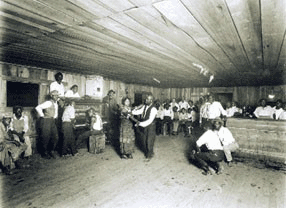
Above is a barrelhouse of the sort where Boogie Woogie was born.
When discussing the “barrelhouse” style of Boogie Woogie pianist, Robert Shaw, the Texas Handbook of History gives the following description of a “barrelhouse:”
“The style was named for the barrelhouses, where it was performed-sheds with walls lined with beer and whiskey, an open floor, and a piano on a raised platform in a corner of the room. The back of the barrelhouse was also used as a bawdy house.”
© 2008 John Tennison
Biography Information Corrections or Additions
Site Information — Mon, Jun 02, 2008
BoogieWoogie.Com is an evolving source of information on boogie woogie. Although we do ongoing research from our primary sources, we are always looking for contributions. If you have information, edits or corrections that would be helpful in this effort, please use the form below to communicate with us. The more information you can give us regarding the source of your information, the better. We cannot provide direct communication with anyone on our site. Our editors review all feedback but we can’t promise that we will be able to respond in every case.
© 2008 BoogieWoogie.Com Webmaster

07 - Boogie Woogie Piano Player Style
History of Boogie Woogie •People — Tue, May 20, 2008
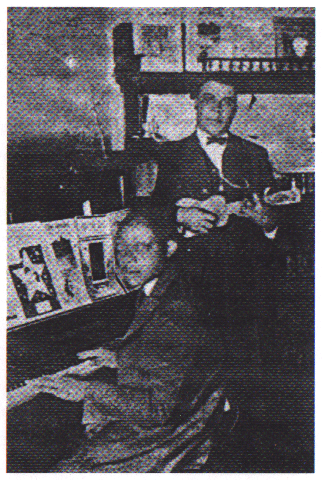
Hersal Thomas (sitting) & older brother George Thomas (standing) (The image above appears on the cover of the CD album "Texas Piano, Vol. 1" by Document Records.)
“The Boogie Woogie piano players had already developed a mature style in the early twenties, yet it waited until 1938 to find ready acceptance in the hot music field, and by such dispensers of musical taste as the arrangers.”
— Frederick Ramsey, Jr. and Charles Edward Smith, 1939, page xiv in the "Introduction" to the book, “Jazzmen: The Story of Hot Jazz Told in the Lives of the Men Who Created It.” 1
If anyone knows of any other pictures of George or Hersal Thomas other than those displayed in this article, please contact me at nonjohn@nonjohn.com.
The Forward of the 1942 sheet music book, "5 Boogie Woogie Piano Solos by All-Star Composers," 12 edited by Frank Paparelli, states:
“This book features for the first time, the works of George and Hersal Thomas. They are credited with discovering the Boogie Woogie style.”
According to music historian, Paul Oliver, this "discovery" was made in East Texas by George W. Thomas, Jr.5
Specifically, on page 85 of the book, "The Story of the Blues," Oliver writes that George W. Thomas “composed the theme of the New Orleans Hop Scop Blues - in spite of its title - based on the blues he had heard played by the pianists of East Texas.” 5
On February 12, 2007, Paul Oliver confirmed to me that it was Sippie Wallace who told him that performances by East Texas pianists had formed the basis for George Thomas’s "Hop Scop Blues." Moreover, Paul Oliver also indicated to me that Sippie had not been specific as to the locations in East Texas at which George Thomas witnessed these pianists.77
(However, in my upcoming book, I will provide an analysis of all evidence that I have collected to develop a coherent theory of the most probable locations within Texas where George and Hersal could have been exposed to specific musical elements later seen in"New Orleans Hop Scop Blues," "The Fives," and "The Rocks," and other pieces by the Thomas brothers.)
© 2008 John Tennison

06 - Steam Locomotives Sang the Blues & Inspired Early Boogie Woogie Musicians
History of Boogie Woogie — Tue, May 20, 2008
In the book, "The Story of the Blues," on page 16 in his chapter titled “Cottonfield Hollers,” 5 historian Paul Oliver wrote:
“When the blues began, the countryside was quiet. Loudest of the sounds to break the stillness was the roar of a steam train as it traced its way through the lowlands, leaving a smudge of smoke against the blue sky. A brief moment of excitement as it passed, a shrill whistle, dipping and wailing like a blues and it would be gone. It’s said that the engineers tuned their steam whistle ‘quills’ to play a blues but it probably just sounded like this to the field hands who knew the hour by the regular trains.”
On page 170 (Chapter 4 "Lonesome Whistles") of the book, "The Land Where the Blues Began,"27 Alan Lomax, wrote:
“Anonymous black musicians, longing to grab a train and ride away from their troubles, incorporated the rhythms of the steam locomotive and the moan of their whistles into the new dance music they were playing in jukes and dance halls. Boogie-woogie forever changed piano playing, as ham-handed black piano players transformed the instrument into a polyrhythmic railroad train.”
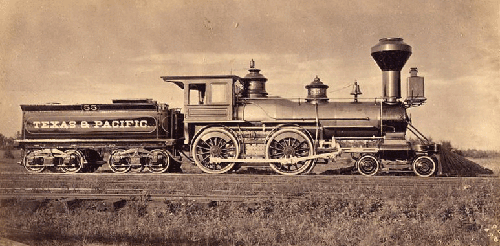
Pictured above is the Texas & Pacific steam locomotive 55, an A-2 Class 4-4-0 manufactured by the Schenectady company. The first steam locomotives used by the Texas & Pacific were built by Rogers Locomotive Works. For an excellent website pertaining to the Texas & Pacific Railway, see http://www.texaspacificrailway.org. For two excellent websites pertaining to general information about steam locomotives, including the Texas & Pacific, see http://www.steamlocomotive.com and http://www.steamlocomotive.info.
In the 1986 television broadcast of Britain’s "South Bank Show" about Boogie Woogie19, music historian, Paul Oliver, noted:
“Now the conductors were used to the logging camp pianists clamoring aboard, telling them a few stories, jumping off the train, getting into another logging camp, and playing again for eight hours, barrelhouse. In this way the music got around—all through Texas—and eventually, of course, out of Texas. Now when this new form of piano music came from Texas, it moved out towards Louisiana. It was brought by people like George Thomas, an early pianist who was already living in New Orleans by about 1910 and writing “New Orleans Hop Scop Blues,” which really has some of the characteristics of the music that we came to know as Boogie.”19
Logging Train in the Piney Woods of East Texas
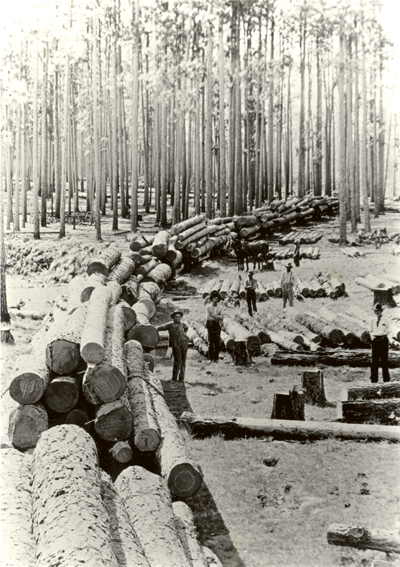
(The image above is from the East Texas Research Center Collection)
© 2008 John Tennison
05 - The Focus of My Inquiry into Boogie Woogie
History of Boogie Woogie — Tue, May 20, 2008
The quotations above from E. Simms Campbell and Clarence Williams are among the earliest accounts that attribute an origin of Boogie Woogie music to a specific geographical region, namely Texas. Their comments above are also noteworthy in that neither E. Simms Campbell nor Clarence Williams were from Texas. Campbell was from St. Louis and spent time living and conducting research in both Chicago and New York. Williams was from Louisiana, and also spent considerable time living in Chicago and New York. Thus, neither man had a conflict of interest or a Texas bias that might have contributed to a distortion in their thinking about the geographical origin of Boogie Woogie. Moreover, in 1986, after many years of researching the development of the Blues in America, historian Paul Oliver corroborated the idea that Boogie Woogie music originated in Texas (See below). Consequently, part of my current analysis will focus on looking at evidence and at the music and migratory patterns of early Texas Boogie Woogie players. At the same time, I want to see if it is possible to account for other early reports of the performance of Boogie Woogie that seem to be geographically discontinuous with the preponderance of early reports. In summary, I hope to engage in a sort of "meta-analysis" that will yield a coherent theory for development of Boogie Woogie that takes into account all known evidence.
I will describe the musical features that distinguish Boogie Woogie. Moreover, when appropriate, I will also take the opportunity to defend the musicality of and dispel misconceptions about Boogie Woogie.
Ultimately, I want to consider Boogie Woogie in a much broader context of human evolution and universal aesthetic sensibilities. Part of this broader consideration will examine how the formal elements of Boogie Woogie have strong correlates and associations with ancient spiritual, religious, and sexual practices.
Another attribution of the geographical origin of Boogie Woogie to Texas was in the radio script, "The Boogie Woogie Beat: Rompin’ Stompin’ Rhythm," (broadcast the week of 1/17/02, Riverwalk script ©2001 by Margaret Moos Pick). Moos wrote [when referring to the developers of the Boogie Woogie]:
“They had a captive audience: loggers from the lumber camps deep in the piney woods, and workers laying track for the Texas and Pacific railroad, carving a line of steel through the wilderness. The sounds of barrelhouse Boogie Woogie spread out in all directions following the path of the newly emerging railroad lines.”
© 2008 John Tennison

04 - Piney Woods of East Texas
History of Boogie Woogie — Tue, May 20, 2008
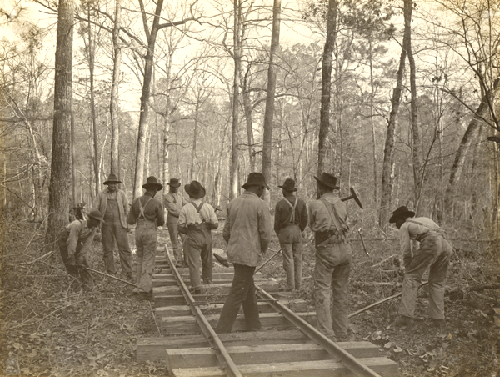
Photo Above: Steel Gang Laying a Logging Railroad in the Piney Woods of East Texas. The image is from the East Texas Research Center Collection.
"Although the neighboring states of Arkansas, Louisiana, and Missouri would also produce boogie-woogie players and their boogie-woogie tunes, and despite the fact that Chicago would become known as the center for this music through such pianists as Jimmy Yancey, Albert Ammons, and Meade Lux Lewis, Texas was home to an environment that fostered creation of boogie-style: the lumber, cattle, turpentine, and oil industries, all served by an expanding railway system from the northern corner of East Texas to the Gulf Coast and from the Louisiana border to Dallas and West Texas." (page 75)13
—Dave Oliphant
Although there is an obvious typographical error in his comments, in "Looking Up at Down: The Emergence of Blues Culture,"76William Barlow writes in Chapter 7, page 231:
"Piano players were the first blues musicians associated with the Deep Ellum tenderloin. In Dallas, Houston, and other cities of Eastern Texas, the prevailing piano style of uptempo blues numbers was called "Fast Western" or "Fast Texas." An offshoot of boogie woogie, it probably came from the "Piney Woods" lumber and turpentine camps based in northwest Texas, northern Louisiana, and southern Arkansas. However, the style became a fixture in "Deep Ellum" after the turn of the century."
Barlow obviously meant to write "northeast Texas," as there were no "Piney Woods" or "turpentine camps" in "northwest Texas." This typo is also obvious in that it is"northeast Texas" that is at the confluence of "northern Louisiana" and "southern Arkansas", an area currently known as the Arklatex. These comments on the origin of Boogie Woogie by Barlow are consistent with the 1899 witnessing by Leadbelly, as well as with the account given by Lee Ree Sullivan of Texarkana.
Moreover, since piano players were the "first blues musicians" in Deep Ellum, Barlow’s comments suggest that Blind Lemon Jefferson might have borrowed his "Booga Rooga" guitar bass figure from Boogie Woogie pianists in Deep Ellum, but given travels with Lead Belly on the T&P line, Jefferson could have also heard such Boogie Woogie pianists at other locations in Texas. Jefferson might have also derived his "Booga Rooga" bass line from Lead Belly, after Leadbelly witnessed Boogie Woogie bass lines played by pianists in the Arklatex.
© 2008 John Tennison
Boogie Woogie Biography Page
Site Information — Tue, May 20, 2008
Historical
© 2008 BoogieWoogie.Com Webmaster

03 - George W. Thomas, Jr.
History of Boogie Woogie •People — Mon, May 19, 2008
On page 2 of his 1940 "Boogie Woogie and Blues Folio,"63 in his annotation to the reprint of the 1923 sheet music of George W. Thomas, Jr.‘s "New Orleans Hop Scop Blues," (first published in 1916 by George W. Thomas) Clarence Williams states:
"The ‘Boogie Woogie’ originated in Texas many years ago. It wasn’t called the ‘Boogie Woogie’ then. George Thomas was the fellow who used this style and first wrote it down."63
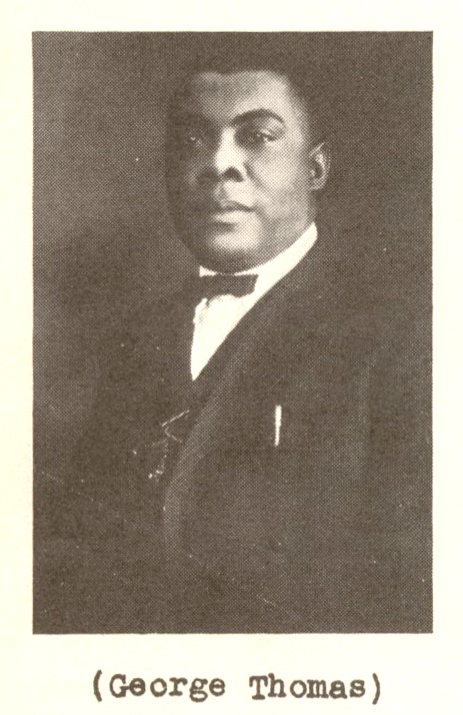
The image above of George Washington Thomas, Jr., is from Page 2 of Clarence Williams’ 1940 "Boogie Woogie and Blues Folio"63
"Texas as the state of origin became reinforced by Jelly Roll Morton who said he heard the boogie piano style there early in the century; so did Leadbelly and so did Bunk Johnson."74
— 1983, Rosetta Reitz [Leadbelly reported hearing Boogie Woogie in 1899. — see section on Leadbelly.]
© 2008 John Tennison

02 - Barrelhouse Pianist
History of Boogie Woogie — Mon, May 19, 2008
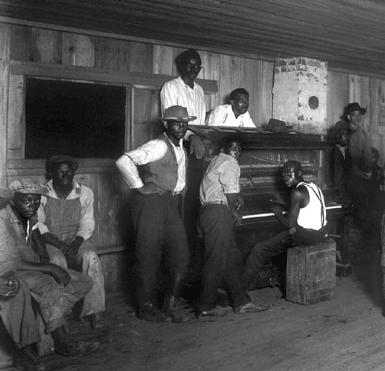
The photo above was taken in Minglewood, TN in 1920. This photo is contained in the Special Collections Photograph Archives of the University of Louisville.
“Boogie Woogie piano playing originated in the lumber and turpentine camps of Texas and in the sporting houses of that state. A fast, rolling bass — giving the piece an undercurrent of tremendous power — power piano playing.”
“Neither Pine Top Smith, Meade Lux Lewis nor Albert Ammons originated that style of playing — they are merely exponents of it.”
“In Houston, Dallas, and Galveston — all Negro piano players played that way. This style was often referred to as a ‘fast western’ or ‘fast blues’ as differentiated from the ‘slow blues’ of New Orleans and St. Louis. At these gatherings the ragtime and blues boys could easily tell from what section of the country a man came, even going so far as to name the town, by his interpretation of a piece.” 1
— E. Simms Campbell, 1939, pages 112-113, (in Chapter 4 "Blues") in the book, "Jazzmen: The Story of Hot Jazz Told in the Lives of the Men Who Created It" 1
Consistent with the findings of E. Simms Campbell are the comments of Elliot Paul, who wrote the following on page 229 in 1957 (in Chapter 10 "Boogie Woogie ") in his book "That Crazy American Music" 78:
"The first Negroes who played what is called boogie woogie, or house-rent music, and attracted attention in city slums where other Negroes held jam sessions, were from Texas. And all the Old-time Texans, black or white, are agreed that boogie piano players were first heard in the lumber and turpentine camps, where nobody was at home at all. The style dates from the early 1870s. Even before ragtime, with its characteristic syncopation and forward momentum, was picked up by whites in the North, boogie was a necessary factor in Negro existence wherever the struggle for an economic foothold had grouped the ex-slaves in segregated communities (mostly in water-front cities along the gulf, the Mississippi and its tributaries)."78
© 2008 John Tennison
Mission Statement
Site Information — Fri, May 09, 2008
Boogie woogie is the backbone of American music. Rhythm and improvisation on a piano, played over a blues form, it is the foundation of jazz and most of American popular music.
Boogie woogie is also America’s forgotten music. Once THE popular music of the country - in fact a national craze - it was transformed in the post WWII years into modern jazz and rock and roll.
This site, BoogieWoogie.Com, is dedicated to documenting - in the words of John Tennison - the origins, subsequent history and ongoing development of boogie woogie. It will also be a resource for all things boogie—the music, the art, the biographies of players, living and dead, and other events promoting the art form.
© 2008 BoogieWoogie.Com Webmaster
Contact Information
Site Information — Fri, May 09, 2008
Here you’ll find our Mailing Address and Phone as well as a form below that you can use to send us a message, comment, suggestion, inquiry, etc. You can also use the email contact links on this page to get in touch with us. Please let us know what you think of the site.
Mailing Address
Boogiewoogie.com
2843 E. Grand River Avenue #119
East Lansing, MI 48823
Phone
(517) 351-6545
© 2008 BoogieWoogie.Com Webmaster
01 - BOOGIE WOOGIE: Its Origin, Subsequent History, and Continuing Development
History of Boogie Woogie — Thu, May 08, 2008
(The web pages here on the BoogieWoogie.Com web site contain only a fraction of the material that I will eventually publish as a book. Never before published material from my own field research into Boogie Woogie will be in this forthcoming book. If you would like a copy, please contact me using the contact information on this page.)
“There is every reason for us to know something about Africa and to understand its past and the way of life of its peoples. Africa is a rich continent that has for centuries provided the world with art, culture, labor, wealth, and natural resources.” 73
and
“But perhaps most important is the fact that fossil evidence indicates that human beings originated in Africa” 73
and
“To be human is to be of African descent.” 73
— George C. Bond, Ph.D., Director, Institute of African Studies, Columbia University, (page 6 of the book, “Chokwe”) 73
Moreover, music historian, Dave Oliphant has written:
“Barrelhouse, boogie-woogie, and jazz all originate to some degree in the religio-sexual customs of primitive African societies, for Wilfrid Mellers 14 notes, one of the meanings of the phrase ‘boogie-woogie,’ and of the word ‘jazz’ itself, is sexual intercourse, even as the ritualistic-orgiastic nature of the music also represents an ecstatic form of a spiritual order.” 13
Thus, as I consider Boogie Woogie, I intend to remain ever mindful that we are all of African descent. Being mindful of this fact suggests certain questions: For example, does Boogie Woogie have its widespread and lasting appeal because of any universal, evolutionary and/or instinctual aesthetic that has been biologically inherited by all human beings? Is there historical and cultural evidence in Africa even today that suggest a common biological heritage and aesthetic sensibility among human beings? If so, what are the elements of this common aesthetic? Does Boogie Woogie share any of these elements? Have the pretensions of so-called “civilization” created historical contexts where some human beings have unknowingly denied their own capacity to appreciate Boogie Woogie?
To the extent that these questions can be answered in the affirmative, Boogie Woogie can be seen in a much larger context than merely being a popular music and dance form originating in the United States. However, before considering Boogie Woogie in such a broad historical context, I want to first examine its evolution within the United States.
© 2008 John Tennison
Archetypes and Antecedents of Piano Blues and Boogie Woogie Style
Articles and Scholarship — Thu, May 08, 2008
This article was written and provided by Eli H. Newberger, M.D. and was originally printed in the Journal of Jazz Studies 1976; 4:84-109. and reproduced here with permission.
Jazz is essentially an improvised music; it is simultaneously composed and performed. "Style" in jazz implies qualities of both composition and performance. "Idiom," "structure," "phrasing," and "technique" are aspects of style, and a study of various jazz styles contrasts musical "personalities" in the fullest sense.
The jazz piano is as old as jazz, and there have been as many jazz piano styles as there have been jazz pianists. Some, however, seem to show particular originality and imagination, and their work has been of influence. The piano blues stylists to whom one can look as archetypes for the piano blues and boogie-woogie school share these attributes.
In general, the performers represented here exhibit an impressive technical command of the piano. This is not a prime requisite for the effective use of the instrument in jazz, however. For that reason, Cripple Clarence Lofton is present, while, for instance, José Iturbi is not.
To capture a sense of style, and to demonstrate the characteristic features of this school of jazz pianism, each of the artists discussed in this article is represented by a typical 12-bar blues improvisation. Principal conceptual and methodologic issues pertaining to the transcription and notation of these choruses are reviewed in a previous study. 1
As did ragtime, piano blues and boogie-woogie derived from many sources. But where ragtime shows in its notated music and its mannered style the manifest influence of nineteenth century European and American "light classical" music, the earthy, gutty vitality of "the blues" partly obscures an earlier, if no less profound, exposure of the West African slave to the religious music of white America.
Consider for a moment that the music of West Africa was, and is only recently acknowledged to be still, a highly sophisticated and traditionalized unwritten form. Certain scales, modes, and rhythmic configurations pertain to particular tribes, regions, secular and ritual functions. 2
Tone-color and inflection are quite important, and there is a highly elaborated correspondence between language and musical sound. Tuned drums, so-called "talking drums," and constantly tunable drums complement a wide variety of percussion and wind instruments which are frequently pretuned to, say, a basic pentatonic or seven-note scale. Simply stated, the governing principles of the music of West Africa are polyphony, relationship of the number of notes in the mode or scale to the rhythmic structure, theme and repeated variations.
Marshall Stearns’s chapter on the American background of jazz dates the "mass blending of the two musical traditions of Europe and West Africa" to around 1800, the time in which the Methodist revival movement known as "The Great Awakening" was gathering momentum. He notes, too, that black preachers—such as Black Harry, who accompanied Bishop Asbury, a founder of the Methodist Church, in his travels—were known before the American Revolution, and that "lining out"—the practice in early New England congregations of answering and embellishing a reader’s chanted or spoken verse, a custom "which lent itself so easily to the West African call-and-response pattern’‘—can be traced back to 1644, when "the Westminster Assembly recommended the adoption of the practice in English churches because the congregation couldn’t read."3
Musical artifacts of the dynamic exchanges which took place between black and white revivalists may yet be heard in black gospel music, a vivid expression of the "black aesthetic," 4 and such white churches as the Holiness Faith Healers. The music of both contains many elements which are central to blues: antiphonal "exchange" between preacher and congregation; repeated rhythmic patterns or "riffs"; and spontaneous improvisations on the words or melody to a hymn. Two quotes from Hear Me Talkin’ to Ya’ perhaps better make the point." 5
Danny Barker says of Bessie Smith:
Bessie Smith was a fabulous deal to watch. She was a pretty large woman and she could sing the blues. She had a church deal mixed up in it. She dominated a stage. . . . If you had any church background, like people who came from the South as I did, you would recognize a similarity between what she was doing and what those preachers and evangelists from there did, and how they moved people. The South had fabulous preachers and evangelists. Some would stand on corners and move the crowds from there. Bessie did the same thing on stage. . . Bessie was in a class with those people. She could bring about mass hypnotism.
And T-Bone Walker of the blues:
The blues? Man, I didn’t start playing the blues ever. That was in me before I was born and I’ve been playing and living the blues ever sInce. . . . Of course, the blues comes a lot from the church, too. The first time I ever heard a boogie-woogie piano was the first time I went to church. That was the Holy Ghost Church in Dallas, Texas. That boogie-woogie was a kind of blues, I guess. Then the preacher used to preach in a bluesy tone sometimes. You even got the congregation yelling" Amen" all the time when his preaching would stir them up—his preaching and his bluesy tone. Lots of people think I’m going to be a preacher when I quit this business because of the way I sing the blues. They say it sounds like a sermon.
Certainly, too, the work song, the field holler, and the later guitar-accompanied "country blues" contributed to what eventually became piano blues and "boogie-woogie." The special pertinence of blues to the black experience shaped this communication. 6
In Speckled Red’s chorus on "Wilkins Street Stomp" (Example 1),7 we note, in addition to a formal, chordal "introduction," a striking right hand device between measures 4 and 10. Alternation of intervals and chords with single notes in a limited range produce an easy ostinato, not unlike a strummed, subtly changing blues solo on the guitar.
With urbanization after the abolition of slavery came the integration at the piano of such diverse elements as the rapid, chugging guitar rhythms of "Fast Western" blues, presumably from the oppressive lumber and turpentine camps; the melancholy "spirituals"; the fervent, frantic "jubilees" and "shouts"; and to a lesser extent, as we see in Cow Cow Davenport‘s solo on "State Street Jive" (Example 2)8, ragtime. Davenport’s performance shows an unusual number of right hand octave and "pivot" figures. His is a barrelhouse style with extreme emphasis on repetition and embroidery; in each chorus in the present recording, the left hand is nearly identical and the right hand incessantly decorates with grace notes, passing voices. and "ragged" eighth notes. Adding further to the "ragtime" sense is the unusual formally repeated "middle section" (measures 5 to 9) which is similarly rarely altered.
The uncommonly fine left hand pattern begins with powerful octaves which migrate into a stunning chromatic run (measures 5, 6). Thereafter broken fifths and a two-measure riff (measures 9 and 10) provide a rocking, shifting accompaniment.
Yet it is notable that Davenport’s cut of "Atlanta Rag"9 sounds as if he is shackled by the ragtime manuscript. There is much the same "eight to the bar" feeling as in the present example, but we have the impression that the performer needs more freedom to improvise.
In addition to its several sundry other meanings, "blues" came later to mean "12-bar blues," the standard three-chord scheme we hear so eloquently improvised in these pages. Stearns remarks that W. C. Handy’s popular "Memphis Blues" was turned down several times because of its "unusual" form before it was published in 1912. And Count Basic. leader of the splendid band that "swings the blues," first heard that "blues" meant only "12-bar blues" in Oklahoma City in 1926 from the celebrated blues singer Jimmy Rushing. who in turn had been so taught by an uncle from the deep South around 1915.10
In Hear Me Talkin’ to Ya’ Bunk Johnson, among others. talks of the blues in New Orleans around the turn of the century:
That was the Crescent City in them days, full of bars , honky-tonks. and barrel houses. A barrel house was just a piano in a hall. There was al ways a piano player working. When I was a kid, I’d go into a barrel house and play ‘long with them piano players ‘til early in the mornin’. We used to play nuthin’ but the blues.11
And Jelly Roll Morton, in the narrative accompaniment to his Library of Congress recordings,12 speaks often of hearing very many solo blues pianists in Storyville whose inventiveness (by Morton standards) might be called into question but who nonetheless improvised original variations.
Perhaps Morton’s objection to the blues he heard had to do with the fact that the melodies in that idiom—particularly in the faster pieces—differed markedly from those which he heard in, say, ragtime and instrumental popular music. For where ragtime’s melodic figures are maintained steadfastly throughout the "piece," altered, perhaps, by grace notes, passing voices, and a rare extra syncopation, such blues as Cripple Clarence Lofton‘s eleven-bar "Blue Boogie" (Example 3),13 and Meade Lux Lewis‘s slower "Far Ago Blues" (Example 4) 14 (admittedly recorded much later by men whose personal styles Morton could not possibly have heard in New Orleans) show "melody" taking form from a few repeated rhythmic figures, or "riffs," such as we hear in measures 1 and 3 in Lofton’s chorus and in measures 6 and 10 in Lewis’s. Generally there are three four-measure phrases in a blues. The 12-bar whole is frequently "filled out" by repetition, chords, and occasional arpeggios or by simply allowing the underlying bass pattern (or, as in Lewis’s solo, bass "line") to carry on alone.
Lofton and Lewis spent much of their lives in Chicago, a city which attracted and produced many superb blues players. There, in fact, began the public renaissance of "boogie-woogie" in the late 1930s and early 1940s prompted by the rerecording of Lewis’s popular" Honky Tonk Train Blues" of 1929 (after, as Leonard Feather reports,15 he was found by critic John Hammond washing cars in a Chicago garage) and by Pine Top Smith‘s splendid "Pine Top’s Boogie-Woogie" of 1928. Lewis, in fact, was one of the major figures of that period, while Lofton, whose tolerant ear and penetrating lack of technical discipline produced many dissonances (such as one hears in measures 1, 2, 7, and 8) and such eleven-bar choruses as this present solo, remained always in relative obscurity.
Montana Taylor was even less known to the general public, having "disappeared" after completing the very productive session from which his solo on "Detroit Rocks" (Example 5)16 was taken. This chorus clearly presents what came to be the archetypal features of popular "boogie-woogie": steady ostinato accompaniment, repeated riffs and triplet patterns, truncated phrases, and simple harmonies. Such right hand ninths as these in measures 4, 6, and 8 are not "atypical," as they inevitably resolve. The clean lines and directness of the chorus are accentuated by a virtual absence of dynamic variation.
Jimmy Yancey is a name that is rather more familiar than Montana Taylor, although ironically he seems to have been publicized mainly by Meade Lux Lewis‘s and Bob Crosby’s recordings of "Yancey Special" in 1936 and 1938, respectively. Subsequently he himself did record, and his solo on "The Fives" or "Five O’Clock Blues" (Example 6)17 displays many features of a style which deeply influenced such figures as Pine Top Smith, Albert Ammons, Cow Cow Davenport, Cripple Clarence Lofton, and Meade Lux Lewis in Chicago in the 1920s. We note a lusty, rocking bass with intervals and accents on the second and fourth beats which contrast with the right hand "riffs" to produce a dazzling series of cross-rhythms through the chorus. Remarkable, too, are such subtleties as dynamic modulation in measure 8 and integration of the "melody" into chords in measures 1, 2, 5, 6, 11, and 12. Yancey’s "slow blues" style was perhaps less raw-boned, though surely as transitive and expressive. He also indulged in a peculiar ritual at the ends of his various works, cadencing in E-flat with an idiosyncratic signature regardless of the key. The Chicago White Sox were fortunate to have him as a groundskeeper for more than thirty years.
Pine Top Smith‘s recording of "Jump Steady Blues" (Example 7)18 reveals a debt to Yancey. This is the second chorus from that performance; it differs in a few important respects from the first. The third measure, hitherto part of the main body of the chorus, becomes an extra introductory measure; where the bass pattern had begun occurs a single chord, and the feeling of phrasing changes accordingly. Between the first beat of measure 4 and the last beat of measure 8, left hand fifths happen on thesecond beat, somewhat as in Yancey’s chorus, with a single exception, thefourth beat of measure 7. The rhythmic variety in the second half of the chorus is still more impressive for conflicts of "triplet" and nearly "straight" eighth notes in measures 7 to 10. A kind of rhythmic resolution takes place in the last two measures, which arc entirely in "triplet" rhythm. In contrast. much of the recording, and a great deal of Pine Top’s playing, has the chugging, "eight-to-the-bar" feeling which to some extent derives from a relative preponderance of more nearly "straight" than "triplet" eighth notes. This is a prominent rhythmic feature of much of the instrumental rhythm-and-blues which stemmed from the same roots as boogie-woogie and which may, in fact, also be seen as a form of "the blues." Just as ragtime sprang in part "from the gutters of Vienna" and contributed some few "African" roots to the songs of Tin Pan Alley, so does "the blues" have its later offspring in rock music today.
Pete Johnson of Kansas City and Albert Ammons of Chicago, in their respective solos on "Lone Star Blues" (Example 8)19 and "Woo Woo" (Example 9)20 play primarily single-note improvisations over their bass patterns, a technique which was widely imitated in the boogie-woogie "revival" by such ersatz practitioners as Freddie Slack and Honey Hill.
While piano blues and boogie-woogie are traditionally played solo—the ostinato left hand presumably supplanting a "rhythm section"—such bands as Bob Crosby’s and Ray McKinley’s played arrangements of boogie-woogie "numbers" in the 1930s, employing some capable pianists to handle the piano chorus but—with notable exceptions, as will be seen in Bob Zurke’ s solo—diluting the intensity and feeling of "blues." Ammons and Johnson, however, each played with bands at various times, the former frequently with drums and bass (the present solo was notated from such a recording), and the latter enjoying success in the late 1920s with the excellent blues singer Joe Turner, whom he met when Turner was tending bar at Piney Brown’s Sunset Cafe in Kansas City. Their styles sharing a certain adroit unsubtlety and tendency to play’ ‘triplet" rather than more nearly "straight" eighth notes, they joined forces to make many vigorous two-piano appearances in clubs and on discs during the boogie-woogie "revival," and, in fact, played and recorded some surprising three-piano boogie-woogie with Meade Lux Lewis in New York in that time.
When Bob Zurke succeeded Joe Sullivan in the Bob Crosby Band in 1936, he played both a "swing" style which seems derived from Fats Waller, Earl Hines, and Teddy Wilson, and the powerful, sincere boogie-woogie which we hear on "Cow Cow Blues" in Example 10.21 After achieving such a measure of popularity as a boogie-woogie player in the late 1930s that he won the Down Beat poll in 1939, he attempted a band of his own which failed. Like very many other jazz pianists—notably Pine Top Smith, who never lived to hear his "Pine Top’s Boogie-Woogie" played far and wide—Zurke lived the last years of his short life in obscurity.
Two singer-pianists who worked in Chicago and also did some superb accompaniment for such more famous shouters as Big Bill Broonzy and Sonny Boy Williamson are Memphis Slim (Peter Chatman) and Big Maceo (Major) Merriwether, whose solos on "44 Blues" and "Chicago Breakdown," respectively, are heard in Examples 1122 and 12.23 If Memphis Slim’s recorded work gives the impression of being less powerful than Big Maceo’s—the latter’s chorus is singular for savage intensity and devilish virtuosity—their styles show special similarities. Each develops tension over a number of choruses, employing progressively growing patterns or relentlessly repeated "riffs" over a more-or-less unchanging ostinato bass. One feels that the sense of rhythm in their playing, as with Jimmy Yancey and Pine Top Smith, is "eight to the bar," consequent of a preponderance of more-nearly-"straight" eighth-note types (note the remarkable conflicts between right hand triplets and left hand couplets in Memphis Slim’s solo), and their works share an unusually deep blues feeling. In Example 11 we hear evidence that Memphis Slim was particularly influenced by Jimmy Yancey. As in Yancey’s chorus (Example 6), there are frequent turns, conflicts between accompaniment eighth notes and treble triplets, fourths and fifths in the left hand, and concise treble patterns.
Bob Zurke’s solo (Example 10) has much of the same churning, thrusting quality of Big Maceo’s. Their mighty left hands, furthermore, sound virtually identical.
Three versatile musicians whose financial needs have brought them through many bands and many styles but whose riffy inventions seem to reveal fundamentally "blues" spirits are Jimmy Blythe, Sammy Price, and Billy Maxted. Only Blythe spent an amount of time in Chicago in the 1920s, but his chorus on "Mr. Freddie Blues" (Example 13),24 unlike Price’s and Maxted’s, shows an abundance of ragtime figures which perhaps belie his close exposure to such influential pianists as Jimmy Yancey. He uses right hand pivot notes in measures 1-4 and 6, a modified two-beat bass in measures 5, 8, and 10, and a kind of rag "release" into measure 5. At the same time his short, discrete phrases, repeated right hand patterns, and heavy, continuous left hand pay homage to the other Chicago blues artists.
Blythe’s solo has a special pianistic quality. The various accents, octaves, left hand anticipations and chords, ornaments, pedal points (measures 11 and 12), and his relatively broad range indicate that Blythe, like many of the blues players and such post-ragtimers (who seem to have affected his playing) as James P. Johnson and Jelly Roll Morton, was attentive to the resources of his instrument.
The syncopated progression in measure 12 of Morton’s "Correct Version" of "Maple Leaf Rag"25 is much the same in sound and sense as the chord series in measure 7 here. Jimmy Blythe, like Johnson and Morton, spent most of his musical career as a soloist. His varied rhythms, willingness to use the entire piano, and exceeding confidence set him apart from many ensemble pianists.
Sammy Price’s bellowing, two-fisted solo on "Lagniappe" (Example 14)26 features incessant syncopation, hearty left hand-right hand exchanges (measures 5, 6), and heavily accented chords. But neither is Price’s left hand a strictly ostinato affair, and like Jimmy Blythe’s, his feeling of time is not always 4/4. The background in this chorus shifts from octaves (measure 1) to stride (measure 2) to chromatics (measures 3,4) to patterns (measures 7,8). His left hand coordinates with his right to outline passing harmony and to shape phrases. And the rhythm charges ahead of or lags behind the strong beats, which, as in measures 2, 3, 4, and 6, are frequently enough the first and third beats to convey a sense close to 2/4 time.
Billy Maxted’s small stature may have much to do with the preponderance of right-hand-fitting chords and intervals in his solo on "Memphis Blues" (Example 15).27 His left hand, furthermore, appears to lean toward linear, chromatic, and within-the-octave patterns. Nonetheless Maxted plays with impressive power, harkening to Bob Zurke, whose hefty unsubtlety and crisp phrasing he shares. Maxted is a pianist whose versatility enables him to sustain an association with the artists and places of New York "dixieland" (he worked at Nick’s both alone and with ensembles for many of the club’s last years). He plays fine, rich blues, similar in many respects to Meade Lux Lewis‘s and Jimmy Yancey’s.
Blues and "boogie-woogie," like ragtime, contributed a certain basic quantity to the evolution of the jazz piano. In the hands of the "New Orleans" and "Stride" pianists, a synthesis of sorts took place. Bluesy patterns and "riffs" came often to be played by, say, Fats Waller, over typical ragtime basses; and, conversely, such artists as Eubie Blake display ragtime-derived decorations and traditional melodies over standard ostinato blues accompaniments.
Often members of ensembles rather than soloists, pianists adapted their styles to integrate with their rhythm sections. They supported other players and had only a chorus or two to impart their message to the audience. So their styles grew, and changed.
NOTES
I. E. Newberger. "The Transition from Ragtime to Improvised Piano Style,"Journal of Jazz Studies 3. no. 2 (Spring 1976): 3-18.
2. The relationships of the performers themselves, as well as the music, to the structure and social life of West African societies, are treated by S. Kinney, "Drummers in Dagbon: The Role of the Drummer in the Damba Festival,"Ethnomusicology 14 (May 1970): 258-65; and D. W. Ames, "Igbo and Hausa Musicians: A Comparative Examination,"Ethnomusicology 17 (May 1973): 250-78.
3. M. Stearns,The Story of Jazz (New York: Oxford, 1956), chap. 8.
4. "Gospel has distilled the aesthetic essence of the black arts into a unified whole. It is a colorful kaleidoscope of black oratory, poetry, drama and dance. One has only to experience a gospel ‘happening’ in its cultural setting to hear black poetry, in the colorful oratory of the black gospel preacher, or to see the drama of an emotion-packed performance of a black gospel choir interacting with its gospel audience, and the resulting shout of the holy dance. It is indeed a culmination of the black aesthetic experience." P. Williams-Jones, "Afro-American Gospel Music: A Crystallization of the Black Aesthetic,"Ethnomusicology 19 (September 1975): 373-385.
5. N. Shapiro and N. Hentoff, eds.,
Hear Me Talkin’ to Ya (New York: Rinehart, 1955), pp. 243, 249-51.
6. "It is interesting to compare the popularity of blues (which stressed suffering) among Blacks with that of black-face minstrel songs (which stressed the simple happiness of blacks), performed widely before white audiences. (Footnote: This difference is roughly comparable to the division between the ‘Uncle Remus’ tales which were projected at white audiences and the more obscene protest tales which circulated only among Blacks.) Each performance was directed toward a racial audience, and their differences suggest the dilemma of the black musician who performed for both white and black audiences. It is clear that the same materials would not be appropriate for each, and thus two distinct repertoires developed." W. R. Ferris, Jr., "Racial Repertoires among Blues Performers,"Ethnomusicology 14 (September 1970): 439-449.
A rich and vivid scholarly study of the meaning of blues—and wry and trenchant commentary on blues scholarship—is found in Charles Keil,Urban Blues (Chicago: University of Chicago Press, 1966). Individual players’ styles can be understood in reference to the social and cultural contexts of their lives, to definable geographic regions, and, importantly, to the changing demands and tastes of the musical marketplace. One scholar’s perceptions of the whole panoply may draw from lyrics in the country idiom: ". . . mules, boll weevils, highways, trains, boxers, prisons, hurricanes, floods, bloodhounds, lawyers, chauffeurs, Pearl Harbor, fire departments, cities, rivers, gambling, beer, whiskey, voodoo, sex," (p. 70), where "In the later city blues styles, like those of the best-known Chicago singers at the present time, the accent is either on bravado and virility or—conversely—helplessness" (p. 71).
7. Brunswick 50414. Recorded in Memphis, Tennessee, January 24, 1929.
8. Brunswick 50414. Recorded in Chicago, July 16, 1928.
9. Riverside SDP 11. The influence of ragtime on piano blues is attributed by Paul Oliver inThe Story of the Blues (Radnor, Pennsylvania: Chilton, 1969) both to the deep ragtime tradition in such cities as St. Louis and Indianapolis (p. 80) and to the generation of the artist: "It is noticeable that the first generation, born a decade later, were exclusively blues players. Most of them seemed to have met at some period in their formative years" (p. 83). Charles Cow Cow Davenport was born in 1894 in Anniston, Alabama, and was "expelled from seminary for playing ragtime," according to biographic notes by Leonard Feather inThe Encyclopedia of Jazz (New York: Bonanza, 1962).
10. Stearns,Story of Jazz, pp. 105-106.
11. Shapiro and Hentoff,Hear Me Talkin’ to Ya, p. 7.
12. A. Lomax,Mister Jelly Roll (New York: Grosset and Dunlap, 1953).
13. Riverside SDP 11. Recorded in Chicago, 1939.
14. Riverside SDP 11. Recorded in New York, 1939.
15. L. Feather,The Encyclopedia of Jazz (New York: Bonanza Books, 1962).
16. Brunswick 50414. Recorded in Chicago, April 23, 1929.
17. Riverside SDP 11. Recorded in Chicago, 1939.
18. Brunswick 50414. Recorded in Chicago, January 14, 1929.
19. Riverside SDP 11. Recorded in New York, April 16, 1939.
20. Columbia CJM 1013. This is a chorus from an ensemble recording led by Harry James.
21. Columbia CJM 1013. Recorded in Chicago, May 8, 1940.
22. Folkways FG 3524. Notes for this 1959 release by Charles Edward Smith, which do not list a recording date, state: "Slim believes this special and original style of playing was created by a man called Ernest ‘Forty-Four.’ The lyrics, not sung on this record, involve a faithless woman and a 44-calibre pistol."
23. RCA LPM 2321. Liner notes by George T. Simon date the recording to 1945. It includes sidemen Tampa Red, guitar, and Charlie Sanders, drums.
24. RCA RLP 1031. Recorded in Chicago, 1926.
25. Newberger, "Transition from Ragtime," pp. 13-14.
26. Jazztone J 1213. This is a chorus from an ensemble recording led by Omer Simeon.
27. Decca 8282. This is a chorus from an ensemble recording led by Eddie Condon.
Eli H. Newberger is writing several articles as part of a larger study on the evolution of jazz piano styles. At Children’s Hospital Medical Center, Boston, he is director of the Family Development, Study. He is also assistant professor of pediatrics at the Harvard Medical School.
© 2008 BoogieWoogie.Com Webmaster

Advisory Board for BoogieWoogie.Com
Site Information — Wed, May 07, 2008
Bob Baldori
Bob is also a current performer of boogie woogie music. For more information see the Seeley and Baldori web site.
John Tennison
John is also the author of the History of Boogie Woogie articles that appear on BoogieWoogie.Com.
© 2008 BoogieWoogie.Com Webmaster

Advertising on BoogieWoogie.Com
Site Information — Wed, May 07, 2008
The page will be updated with more information shortly.
© 2008 BoogieWoogie.Com Webmaster

About BoogieWoogie.Com
Site Information — Wed, May 07, 2008
Boogie woogie is piano based dance music - rhythm and improvisation over a blues form. It is the backbone of American music, the foundation for both modern jazz and American pop music. It is also America’s “forgotten” music. A national craze in the post war years, it evolved into modern jazz and rock in the 1950s, and was largely forgotten by the general public. Until now. We will be expanding on the meaning of boogie woogie as we develop this site, as well as documenting the origins and evolution of the form.
For information about the goals and purpose of this site see our Mission Statement. If you would like to contact someone at BoogieWoogie.Com then see our Contact Page. Our Board of Advisors page lists some of the people giving the site direction. And for a full list of the main web pages on the site see our Sitemap.
Some History
A new version of the BoogieWoogie.Com web site was launched in May 2008 after the domain moved to new ownership.
Creative Team
Kelly Boyle
Kelly is an Artist supplying the visuals for the version of the web site launched in May 2008. Her web site is www.kellyartprints.com.
Robert K. Foster
A web site designer for the version of the site launched in May 2008. His web design company can be found online at Windjammer Company LLC.
© 2008 BoogieWoogie.Com Webmaster

More Information Here Shortly
Site Information — Wed, May 07, 2008
Currently this page has not been completed. The page will be updated with more information shortly.
© 2008 BoogieWoogie.Com Webmaster
About the Author of “The History of Boogie Woogie”
History of Boogie Woogie — Wed, May 07, 2008
John Tennison (also known as “Nonjohn”) was born in 1968 in Texarkana, Texas. Texarkana is located in the Red River Valley in Bowie County at the far northeastern corner of Texas. Texarkana is continuous with the Texas Piney Woods and swamp lands that were the fertile ground where the piano style we now know as “Boogie Woogie” is said to have first been played, and where the term “Boogie Woogie” is reported to have transitioned from being a term for dancing and sexual behavior to also being a descriptor for the style of piano music we now know as Boogie Woogie.
Consequently, John Tennison’s exposure to and interest in Boogie Woogie is a direct consequence of Texarkana’s Boogie Woogie heritage. Tennison plays highly-original Boogie Woogies as a form of daily yogic meditation directed by his spontaneous mental impulses. As a consequence, Tennison’s Boogie Woogie performances are in the spirit of “free jazz,” and are thus improvisatory to the degree of not only improvising melodic and rhythmic elements, but also of improvising harmonic changes, tempo changes, and meter changes.
Tennison performs Boogie Woogie in his current home town of San Antonio, Texas, where he performed with drummers, such as Bobby Natanson, Gerry Gibbs, and Kyle Keener. Tennison also performed in Europe at Silvan Zingg’s International Boogie Festival in Switzerland in 2006.
In 2004, Tennison founded The Boogie Woogie Foundation (BoWoFo), a non-profit organization established to foster research, to promote, and to increase the general public knowledge of the origin, history, and broad influence that the Boogie Woogie has had. The BoWoFo website is at www.bowofo.org.
Tennison is also writing a book that will deal heavily with the early history of Boogie Woogie. In particular, Tennison’s book will focus on the evolution of Boogie Woogie from at least as early as the 1870s through 1930. The book will also deal with various ways in which Boogie Woogie continues to influence multiple styles of music that are not necessarily called “Boogie Woogie.”
© 2008 John Tennison
References for “The History of Boogie Woogie”
History of Boogie Woogie — Tue, Apr 01, 2008
1.
"Jazzmen", 1939, by Harcourt Brace Jovanovich, Inc., New York, edited by Frederick Ramsey, Jr. and Charles Edward Smith. [Chapter 4 ("Blues") by E. Simms Campbell and Chapter 8 ("Boogie Woogie") by William Russell provide important details on the history of Boogie Woogie.]
2.
"The New Harvard Dictionary of Music," 1986, by the Belknap Press of Harvard University Press.
3.
“Existentialism,“1974, Edited by Robert C. Solomon, University of Texas, Modern Library, New York.
4.
"The White Negro," (essay), 1957, by Norman Mailer.
5.
"The Story of the Blues," 1969, by Paul Oliver, London.
6.
"Hendersonia", 1973, by Walter C. Allen, Jazz Monographs Number 4
7.
“The History of the Blues,“1995, by Francis Davis, Hyperion, New York.
8.
"They All Played Ragtime," 1950, by Rudi Blesh and Harriet Janis.
9.
"The Story of Boogie Woogie: A Left Hand Like God," 1988, by Peter J. Silvester, with a special contribution from Denis Harbinson, Quartet Books Limited, A Member of the Namara Group, London (Reprinted in 1990 by Omnibus Press, London).
10.
"The Music of Conlon Nancarrow," 1995, by Kyle Gann, Cambridge University Press.
11.
"Whistle in the Piney Woods: Paul Bremond and the Houston, East and West Railway," 1999, by Robert S. Maxwell, University of North Texas Press.
12.
"5 Boogie Woogie Piano Solos by All-Star Composers" (a book of sheet music), Copyright 1942, edited by Frank Paparelli, Leeds Music Corporation, RKO Building, Radio City, New York, NY.
13.
"Texan Jazz," 1996, by Dave Oliphant, University of Texas Press.
14.
"Music in a New Found Land: Themes and Developments in the History of American Music, " 1964, by Wilfrid Mellers, Alfred A. Knopf, Inc., New York.
15.
“Jazz Styles: History and Analysis," Seventh Edition, Chapter 2 ("What is Jazz?"), by Mark C. Gridley, Prentice Hall, Inc. 2000.
16.
"Blind Lemon Jefferson: The Complete Classic Sides Remastered," 4-CD Box Set, Liner Notes by Drew Kent, JSP Records, 2003, England.
17.
"Boogie Woogie Piano Styles—No. 1: The History, Development and Art of Playing the Boogie Woogie Style” By Sharon Pease, Copyright 1940 by Forster Music Publisher, Inc., Chicago, IL
18.
"The Boogie Woogie Beat: Rompin’ Stompin’ Rhythm", Radio Broadcast for the week of 1/17/02, Based on Riverwalk, script ©2001 by Margaret Moos Pick
19.
The "South Bank Show" (educational television series in Great Britain), episode on Boogie Woogie, 1986, with commentary by Music Historian, Paul Oliver
20.
Deep Blues, by Robert Palmer, published in 1981 by Viking Penguin, Inc.
21.
Down Beat, July 1939, page 22, “Boogie Piano Was Hot Stuff in 1904” article by Onah L. Spencer
22.
"Blind Lemon Jefferson: His Life, His Death, and His Legacy," by Robert Uzzel, 2002, Eakin Press, Austin, TX.
23.
"Tolbert’s Texas" by Frank X. Tolbert, 1983, Doubleday and Company, Inc.
24.
“The Devil’s Music: A History of the Blues”, Second Edition, 1997, by Giles Oakley, De Capo Press (based on the 5-part BBC-TV documentary “The Devil’s Muisc”)
25.
"The Life and Legend of Leadbelly," 1992, by Charles Wolfe and Kip Lornell, Harper Collins Publishers
26.
“The Eighty-Six Years of Eubie Blake,” LP Music Album, Columbia Records C2S 847
, Stereo, Produced by John Hammond
, 2 records, 4 sides, Liner Notes by Robert E. Kimball, Yale University. ("Eubie’s Boogie" is Track 5 on Side 1 of the first record.)
27.
"The Land Where the Blues Began," 1993, by Alan Lomax, The New Press, New York, NY.
28.
"Bluesland: Portraits of Twelve Major American Blues Masters," edited by Pete Welding & Toby Byron, Penguin Books, Ltd., 1991.
29.
“Chuck Berry: The Autobiography,” 1987, by Chuck Berry, Faber and Faber.
30.
“Meeting the Blues,” 1988, by Alan Govenar, Taylor Publishing Company, Dallas, Texas.
31.
"Texas Handbook of History" in article on "Prostitution" by David C. Humphrey (Full article is online..)
32.
"Blues Piano" - Documentary with interview of Ray Charles by Clint Eastwood. (Part of the Martin Scorsese Presents the Blues Series) .
33.
"Ray" - The 2004 biographical movie about the life of Ray Charles. The movie erroneously substitutes the word, "Stride" for "Boogie Woogie." Sadly, in the film, the term "Boogie Woogie" is used in a derogatory fashion by a white racist country musician.
34.
"Women’s Status in Texarkana, Texas in the Progressive Era, 1880-1920," 2002, by Beverly J. Rowe, Women’s Studies, Volume 37, The Edwin Mellen Press.
35.
"Just Jazz," edited by Sinclair Traill and The Hon Gerald Lascelles, Chapter 2. "Boogie Woogie" (pages 13-40) written by Ernest Borneman, published 1957 in Great Britain for Peter Davies Ltd by The Windmill Press, Kingswood, Surrey.
36.
“Everybody’s just wild about Eubie”.
—article by Peter Hanley, copyright 2003.
37.
Swing Music Magazine, Quotation from Jazz reviewer, John Goldman in 1936 (Exact volume and date of Swing Music Magazine is uncertain. Quotation was taken from page 133 of reference #9 above).
38.
"The Smithsonian Collection of Classic Jazz, Revised Edition," 1987, selected and annotated by Martin Williams, (with a biological index by Ira Gitler), Smithsonian Institution Press.
39.
"The 35 Best Ghost Towns In East Texas and 220 Other Towns We Left Behind," 1988, by Bob Bowman, Copyright 1988 by Bob Bowman & Associates.
40.
"What Do They Want?," 1990, by Sammy Price (This is his autobiography.), University of Illinois Press.
41.
"Pine Apple Rag," 1908, by Scott Joplin, Seminary Music Company, New York, Copyright 1908.
42.
"Pastime Rag No. 1 (A Slow Drag)," 1913, by Artie Matthews, published in 1913 by Stark Music Company, St. Louis, MO
43.
Jazz Record (magazine), April 15, 1943 issue, (edited by Art Hodes, musician and promoter of Cow Cow Davenport)
44.
"But Only Some of Them Played Boogie Woogie" - a qualifier from Nonjohn in response to the book titled, "They All Played Ragtime," 1950, by Rudi Blesh and Harriet Janis.
45.
"Record Research", Issue #81, (published January, 1967), comments by Victoria Spivey from 1966.
46.
"Texas Barrelhouse Piano" (album) by Robert Shaw (A.K.A. "The Ma Grinder"), 1963, Arhoolie Records (re-released on CD on Arhoolie CD 377)
47.
Handbook of Texas, article titled "Railroads" by George C. Werner
48.
The Varieties of Religious Experience, by William James, M.D.
49.
www.juneteenth.com/history.htm
50.
Handbook of Texas Online - article titled "LONGVIEW AND SABINE VALLEY RAILWAY," http://www.tsha.utexas.edu/handbook/online/articles/LL/eql6.html.
51.
Handbook of Texas Online - article titled "TEXAS AND PACIFIC RAILWAY," http://www.tsha.utexas.edu/handbook/online/articles/TT/eqt8.html.
52.
Handbook of Texas Online - article titled "CIVIL WAR" http://www.tsha.utexas.edu/handbook/online/articles/CC/qdc2.html
53.
Handbook of Texas Online - article titled "ATCHISON, TOPEKA AND SANTA FE RAILWAY SYSTEM" http://www.tsha.utexas.edu/handbook/online/articles/AA/eqa10.html
54.
Handbook of Texas Online - article titled "TEXAS WESTERN RAILROAD" http://www.tsha.utexas.edu/handbook/online/articles/TT/eqt20.html
55.
Down Beat, February 19, 1959, "Meade Lux Lewis: A Blues Man’s Story," page 16-17.
56.
"Brother Ray: Ray Charles’ Own Story" (autobiography of Ray Charles), Copyright 1978 by Ray Charles & David Ritz, first published in 1978, re-published in 1992 by De Capo Press
57.
"This is Ragtime" by Terry Waldo, 1976, Hawthorn Books, Inc., New York.
58.
"Reminiscing with Noble Sissle and Eubie Blake" by Robert Kimball and William Bolcom, first published in New York in 1973, Re-printed by Cooper Square Press, 2000.
59.
"5 Famous Boogie Woogie and Blues Solos by Sammy Price"—1943 Folio by Leeds Music Corporation, New York.
60.
"Nameless Towns: Texas Sawmill Communities, 1880-1942," by Thad Sitton and James H. Conrad, 1998, University of Texas Press, Austin.
61.
"Sawdust Empire: The Texas Lumber Industry, 1830-1940," by Robert S. Maxwell and Robert D. Baker, 1983, Texas A&M University Press, College Station, Texas.
62.
"The Art of Jazz: Essays on the Nature and Development of Jazz," edited by Martin Williams, Contains chapter "Three Boogie-Woogie Blues Pianists," (pages 95-109), by William Russell, Oxford University Press, 1959.
63.
"Clarence Williams Presents: The ‘Boogie Woogie’ Blues Folio" ("With Annotations by Clarence Williams"), Copyright 1940, by Clarence Williams Publishing Company, 145 W. 45th St., New York, New York.
64.
"They Have a Word for It : A Lighthearted Lexicon of Untranslatable Words and Phrases," by Howard Rheingold, Published 2000 by Sarabande Books
65.
Liner Notes from CD Box set, "Blind Lemon Jefferson: The Complete Classic Sides Remastered," JSP Records, 2003.
66.
Liner Notes from "Texas Barrelhouse Piano" by Mack McCormick, released the Almanac Book and Record Company, Houston, Texas (This album was later re-issued by Arhoolie Records under the same name of "Texas Barrelhouse Piano." (See Reference 46 above.))
67.
Handbook of Texas Online, article titled, "BLUES," by Alan Govenar, http://www.tsha.utexas.edu/handbook/online/articles/BB/xbb1.html
68.
Interview with Lee Ree Sullivan, Boogie Woogie pianist, 1986, Texarkana, AR-TX, by John Tennison and Alfred Tennison, Jr.
69.
Texarkana Trivia Game, published in 1980s, by Texarkana Kiwanis Club and the Texarkana Work Center.
70.
Album: "Sippie Wallace Sings the Blues," Liner Notes by Paul Oliver, 1967, released by Storyville Records, recorded October 23, 1966, Copenhagen.
71.
Ragtime: A Musical and Cultural History, by Edward A. Berlin, re-published by www.backinprint.com, December 2002.
72.
"Southern Rag Medley No. 2" by Blind Boone, published 1909
73.
Quote by George C. Bond, Ph.D., Director, Institute of African Studies, Columbia University, Page 6, in “Chokwe,” by Manuel Jordan, Ph.D., a title in the “Heritage Library of African Peoples,” 1998, by the Rosen Publishing Group, Inc., New York
74.
LP Liner Notes by Rosetta Reitz for Album: "Boogie Blues: Women Sing and Play Boogie Woogie," 1983, Rosetta Records, New York, NY
75.
Email dialogue between Morgan Wright and John Tennison, August, 2006
76.
"Looking Up at Down: The Emergence of Blues Culture," by William Barlow, 1989, Temple University Press
77.
Interview with Paul Oliver, February 12, 2007
78.
"That Crazy American Music" by Elliot Paul, 1957, Published by Bobbs-Merrill, Indianapolis and New York



